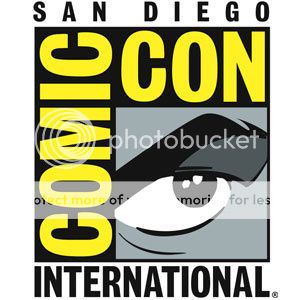
As Comic-Con winds down on the shortened Day 4, we conclude our coverage with two panels that exemplify what Comic-Con is all about. As promised, we dissect the “Comics Design” panel of the world’s top logo designers deconstructing their work, coupled with images of their work. We also bring you an interesting panel of ethnographers, consisting of undergraduate and graduate student, studying the culture and the varying forces that shape Comic-Con. Seriously, they’re studying nerds! Finally, we are delighted to shine our ScriptPhD.com spotlight on new sci-fi author Charles Yu, who presented his new novel at his first (of what we are sure are many) Comic-Con appearance. We sat down and chatted with Charles, and are pleased to publish the interview. And of course, our Day 4 Costume of the Day. Comic-Con 2010 (through the eyes of ScriptPhD.com) ends under the “continue reading” cut!
Comics Design

We are not ashamed to admit that here at ScriptPhD.com, we are secret design nerds. We love it, particularly since good design so often elevates the content of films, television, and books, but is a relatively mysterious process. One of THE most fascinating panels that we attended at Comic-Con 2010 was on the design secrets behind some of your favorite comics and book covers. A panel of the world’s leading designers revealed their methodologies (and sometimes failures) in the design process behind their hit pieces, lifting the shroud of secrecy that designers often envelop themselves in. An unparalleled purview into the mind of the designer, and the visual appeal that so often subliminally contributes to the success of a graphic novel, comic, or even regular book. We do, as it turns out, judge books by their covers.
As promised, we revisit this illuminating panel, and thank Christopher Butcher, co-founder of The Toronto Comic Arts Festival and co-owner of The Beguiling, Canada’s finest comics bookstore. Chris was kind enough to provide us with high-quality images of the Comics Design panel’s work, for which we at ScriptPhD.com are grateful. Chris had each of the graphic artists discuss their work with an example of design that worked, and design that didn’t (if available or so inclined). The artist was asked to deconstruct the logo or design and talk about the thought process behind it.
Mark Ciarello – (art + design director at DC Comics)
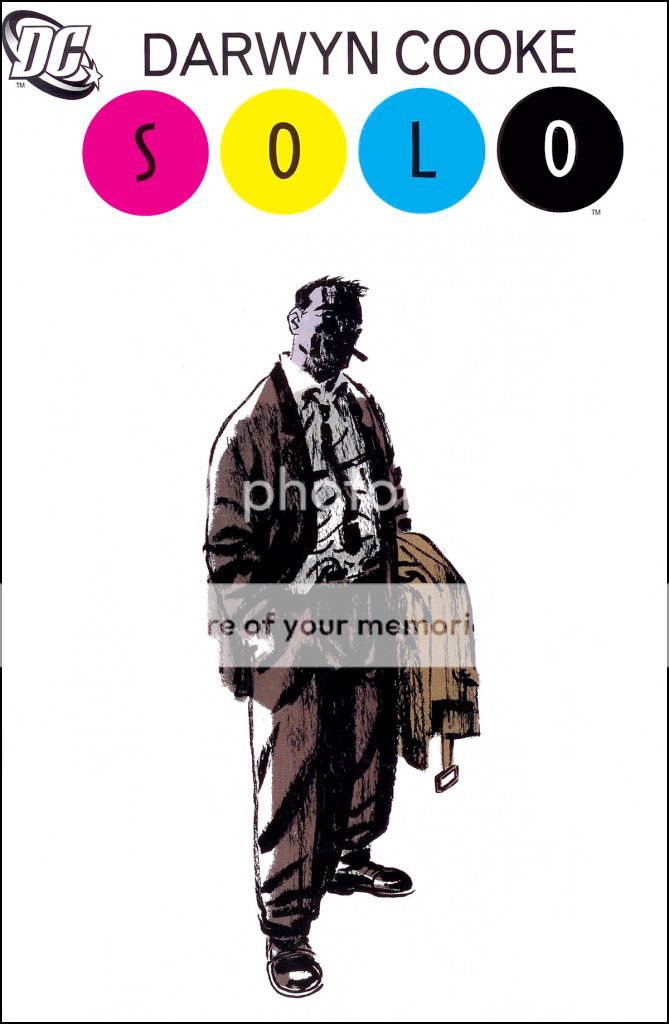
Mark chose to design the cover of this book with an overall emphasis on the individual artist. Hence the white space on the book, and a focus on the logo above the “solo” artist.
Adam Grano – (designer at Fantagraphics)

Adam took the title of this book quite literally, and let loose with his design to truly emphasize the title. He called it “method design.” He wanted the cover to look like a drunken dream.
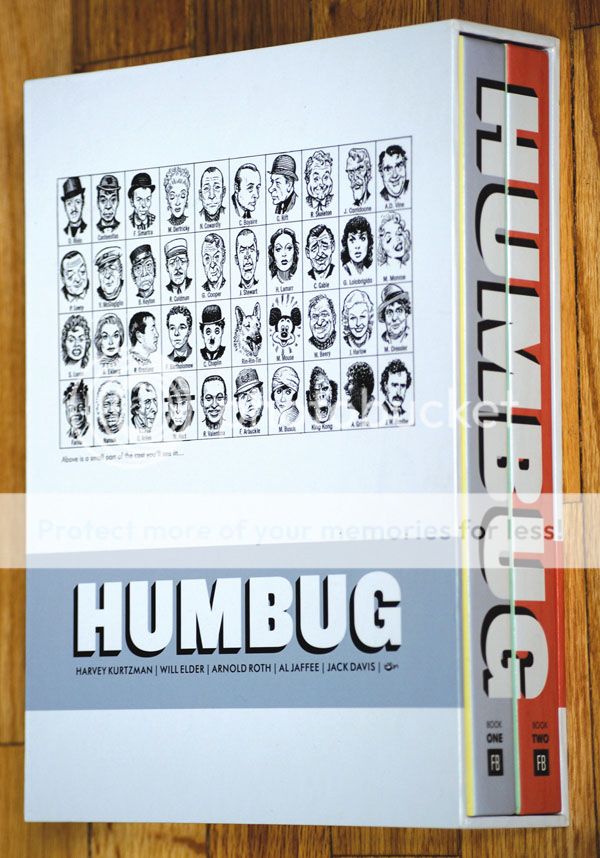
For the Humbug collection, Grano tried hard not to impress too much of himself (and his tastes) in the design of the cover. He wanted to inject simplicity in a project that would stand the test of time, because it was a collector’s series.
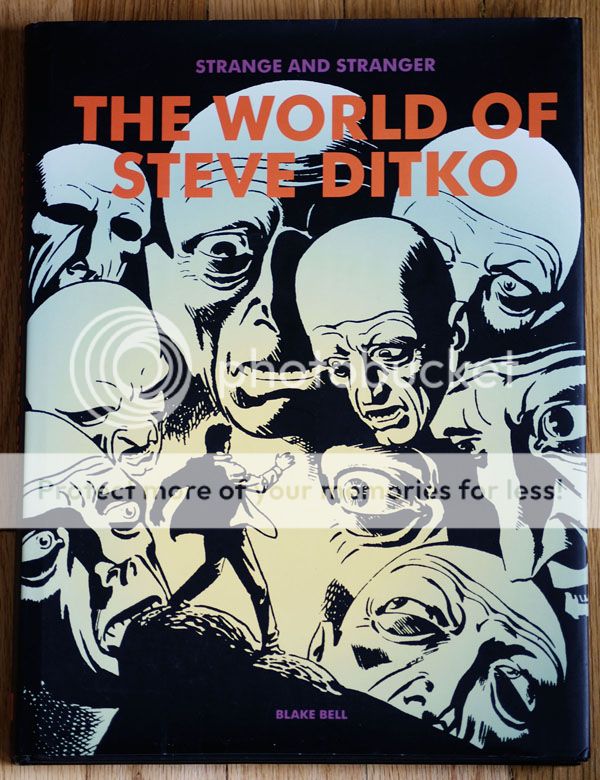
Grano considered this design project his “failure.” It contrasts greatly with the simplicity and elegance of Humbug. He mentioned that everyone on the page is scripted and gridded, something that designers try to avoid in comics.
Chip Kidd – (designer at Random House)
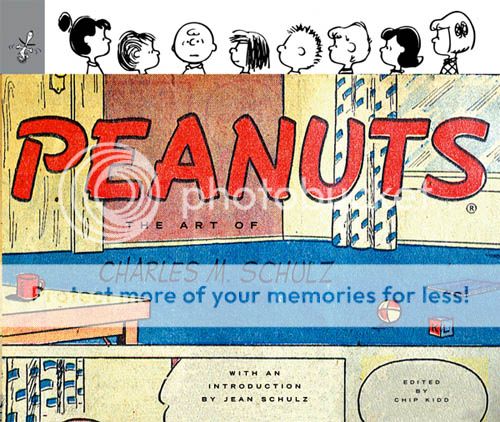
Chip Kidd had the honor of working on the first posthumous Peanuts release after Charles M. Schultz’s death, and took to the project quite seriously. In the cover, he wanted to deconstruct a Peanuts strip. All of the human element is taken out of the strip, with the characters on the cover up to their necks in suburban anxiety.
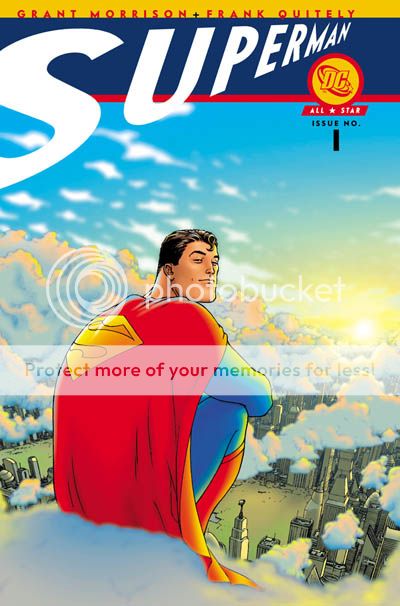
Kidd likes this cover because he considers it an updated spin on Superman. It’s not a classic Superman panel, so he designed a logo that deviated from the classic “Superman” logo to match.
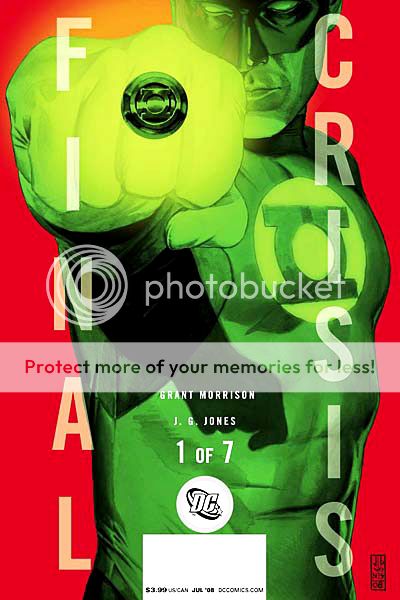
Kidd chose this as his design “failure”, but not the design itself. The cover represents one of seven volumes, in which the logo pictured disintegrates by the seventh issue, to match the crisis in the title. Kidd’s only regret here is that he was too subtle. He wishes he’d chosen to start the logo disintegration progression sooner, as there’s very little difference between the first few volumes.
Fawn Lau – (designer at VIZ)

Fawn was commissioned to redesign this book cover for an American audience. Keeping this in mind, and wanting the Japanese animation to be more legible for the American audience, she didn’t want too heavy-handed of a logo. In an utterly genius stroke of creativity, Lau went to an art store, bought $70 worth of art supplies, and played around with them until she constructed the “Picasso” logo. Clever, clever girl!
Mark Siegel – (First Second Books)
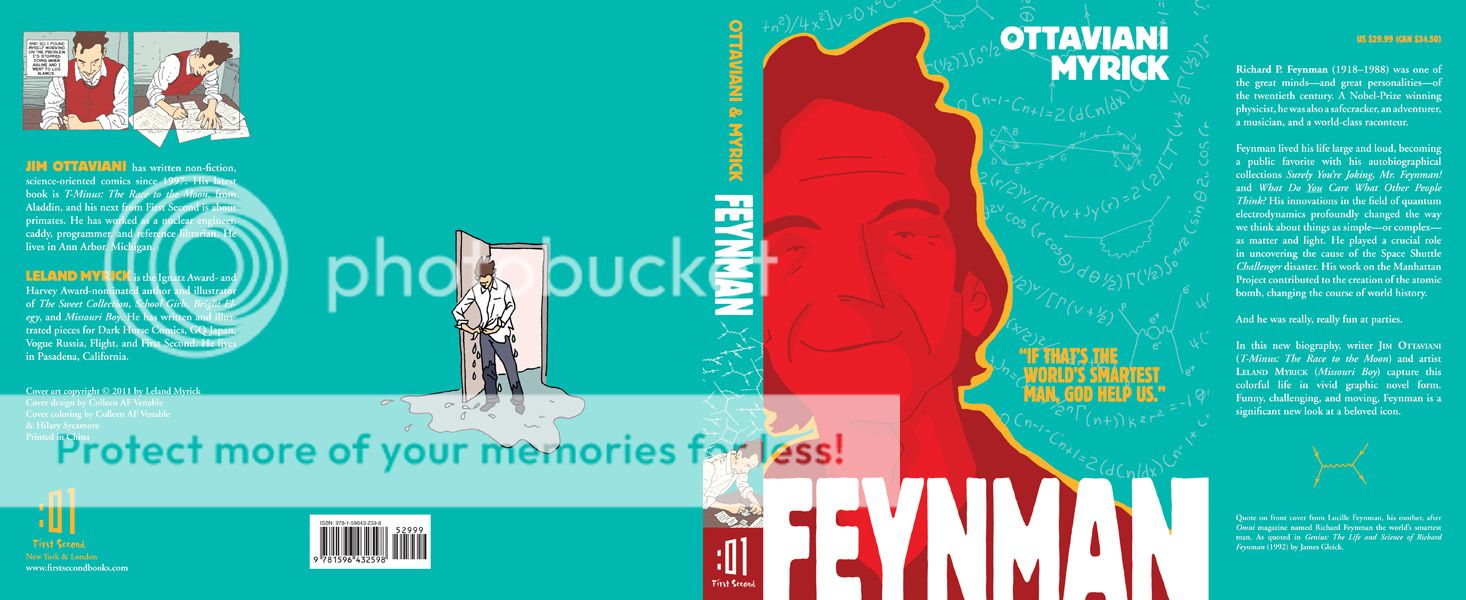
Mark Siegel was hired to create the cover of the new biography Feynman, an eponymous title about one of the most famous physicists of all time. Feynman was an amazing man who lived an amazing life, including a Nobel Prize in physics in 1965. His biographer, Ottaviani Myrick, a nuclear physicist and speed skating champion, is an equally accomplished individual. The design of the cover was therefore chosen to reflect their dynamic personalities. The colors were chosen to represent the atomic bomb and Los Alamos, New Mexico, where Feynman assisted in the development of The Manhattan Project. Incidentally, the quote on the cover – “If that’s the world’s smartest man, God help us!” – is from Feynman’s own mother.
Keith Wood – (Oni Press)

Wood remarked that this was the first time he was able to do design on a large scale, which really worked for this project. He chose a very basic color scheme, again to emphasize a collection standing the test of time, and designed all the covers simultaneously, including color schemes and graphics. He felt this gave the project a sense of connectedness.
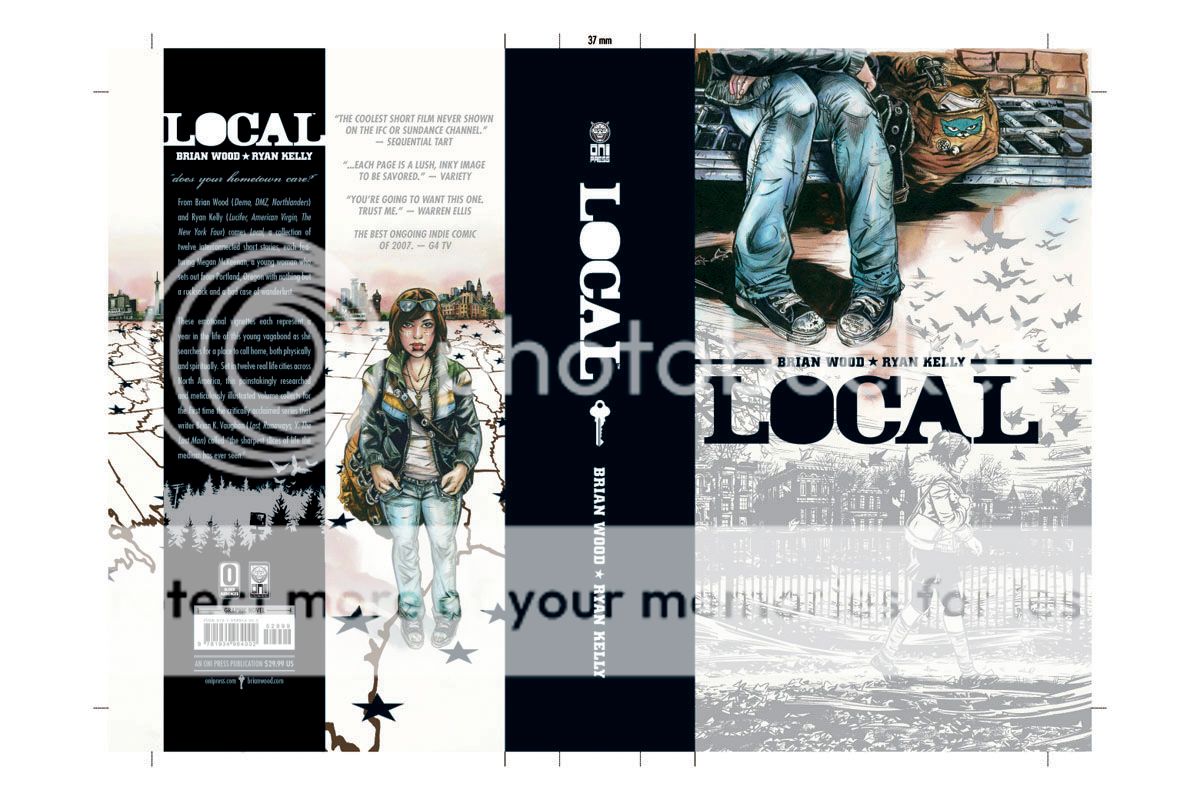
Wood chose a pantone silver as the base of this design with a stenciled typeface meant to look very modern. The back of the cover and the front of the cover were initially going to be reversed when the artists first brought him the renderings. However, Wood felt that since the book’s content is about the idea of a girl’s traveling across the United States, it would be more compelling and evocative to use feet/baggage as the front of the book. He was also the only graphic artist to show a progression of 10-12 renderings, playing with colors, panels and typeface, that led to the final design. He believes in a very traditional approach to design, which includes hand sketches and multiple renderings.
The Culture of Popular Things: Ethnographic Examinations of Comic-Con 2010

Each year, for the past four years, Comic-Con ends on an academic note. Matthew J. Smith, a professor at Wittenberg University in Ohio, takes along a cadre of students, graduate and undergraduate, to study Comic-Con; the nerds, the geeks, the entertainment component, the comics component, to ultimately understand the culture of what goes on in this fascinating microcosm of consumerism and fandom. By culture, the students embrace the accepted definition by famous anthropologist Raymond J. DeMallie: “what is understood by members of a group.” The students ultimately wanted to ask why people come to Comic-Con in general. They are united by the general forces of being fans; this is what is understood in their group. After milling around the various locales that constituted the Con, the students deduced that two ultimate forces were simultaneously at play. The fan culture drives and energizes the Con as a whole, while strong marketing forces were on display in the exhibit halls and panels.
Maxwell Wassmann, a political economy student at Wayne State University, pointed out that “secretly, what we’re talking about is the culture of buying things.” He compared Comic-Con as a giant shopping mall, a microcosm of our economic system in one place. “If you’ve spent at least 10 minutes at Comic-Con,” he pointed out, “you probably bought something or had something tried to be sold to you. Everything is about marketing.” As a whole, Comic-Con is subliminally designed to reinforce the idea that this piece of pop culture, which ultimately advertises an even greater subset of pop culture, is worth your money. Wassmann pointed out an advertising meme present throughout the weekend that we took notice of as well—garment-challenged ladies advertising the new Green Hornet movie. The movie itself is not terribly sexy, but by using garment-challenged ladies to espouse the very picture of the movie, when you leave Comic-Con and see a poster for Green Hornet, you will subconsciously link it to the sexy images you were exposed to in San Diego, greatly increasing your chances of wanting to see the film. By contrast, Wassmann also pointed out that there is a concomitant old-town economy happening; small comics. In the fringes of the exhibition center and the artists’ space, a totally different microcosm of consumerism and content exchange.

Kane Anderson, a PhD student at UC Santa Barbara getting his doctorate in “Superheroology” (seriously, why didn’t I think of that back in graduate school??), came to San Diego to observe how costumes relate to the superhero experience. To fully absorb himself in the experience, and to gain the trust of Con attendees that he’d be interviewing, Anderson came in full costume (see above picture). Overall, he deduced that the costume-goers, who we will openly admit to enjoying and photographing during our stay in San Diego, act as goodwill ambassadors for the characters and superheroes they represent. They also add to the fantasy and adventure of Comic-Con goers, creating the “experience.” The negative side to this is that it evokes a certain “looky-loo” effect, where people are actively seeking out, and singling out, costume-wearers, even though they only constitute 5% of all attendees.
Tanya Zuk, a media masters student from the University of Arizona, and Jacob Sigafoos, an undergraduate communications major at Wittenberg University, both took on the mighty Hollywood forces invading the Con, primarily the distribution of independent content, an enormous portion of the programming at Comic-Con (and a growing presence on the web). Zuk spoke about original video content, more distinctive of new media, is distributed primarily online. It allows for more exchange between creators and their audience than traditional content (such as film and cable television), and builds a community fanbase through organic interaction. Sigafoos expanded on this by talking about how to properly market such material to gain viral popularity—none at all! Lack of marketing, at least traditional forms, is the most successful way to promote a product. Producing a high-quality product, handing it off to friends, and promoting through social media is still the best way to grow a devoted following.
And speaking of Hollywood, their presence at Comic-Con is undeniable. Emily Saidel, a Master’s student at NYU, and Sam Kinney, a business/marketing student at Wittenberg University, both took on the behemoth forces of major studios hawking their products in what originally started out as a quite independent gathering. Saidel tackled Hollywood’s presence at Comic-Con, people’s acceptance/rejection thereof, and how comics are accepted by traditional academic disciplines as didactic tools in and of themselves. The common thread is a clash between the culture and the community. Being a member of a group is a relatively simple idea, but because Comic-Con is so large, it incorporates multiple communities, leading to tensions between those feeling on the outside (i.e. fringe comics or anime fans) versus those feeling on the inside (i.e. the more common mainstream fans). Comics fans would like to be part of that mainstream group and do show interest in those adaptations and changes (we’re all movie buffs, after all), noted Kinney, but feel that Comic-Con is bigger than what it should be.
But how much tension is there between the different subgroups and forces? The most salient example from last year’s Con was the invasion of the uber-mainstream Twilight fans, who not only created a ruckus on the streets of San Diego, but also usurped all the seats of the largest pavilion, Hall H, to wait for their panel, locking out other fans from seeing their panels. (No one was stabbed.) In reality, the supposed clash of cultures is blown out of proportion, with most fans not really feeling the tension. To boot, Seidel pointed out that tension isn’t necessarily a bad thing, either. She gave a metaphor of a rubber band, which only fulfills its purpose with tension. The different forces of Comic-Con work in different ways, if sometimes imperfectly. And that’s a good thing.
Incidentally, if you are reading this and interested in participating in the week-long program in San Diego next year, visit the official website of the Comic-Con field study for more information. Some of the benefits include: attending the Comic-Con programs of your choice, learning the tools of ethnographic investigation, and presenting the findings as part of a presentation to the Comics Arts Conference. Dr. Matthew Smith, who leads the field study every year, is not just a veteran attendee of Comic-Con, but also the author of The Power of Comics.
COMIC-CON SPOTLIGHT ON: Charles Yu, author of How To Live Safely in a Science Fictional Universe.
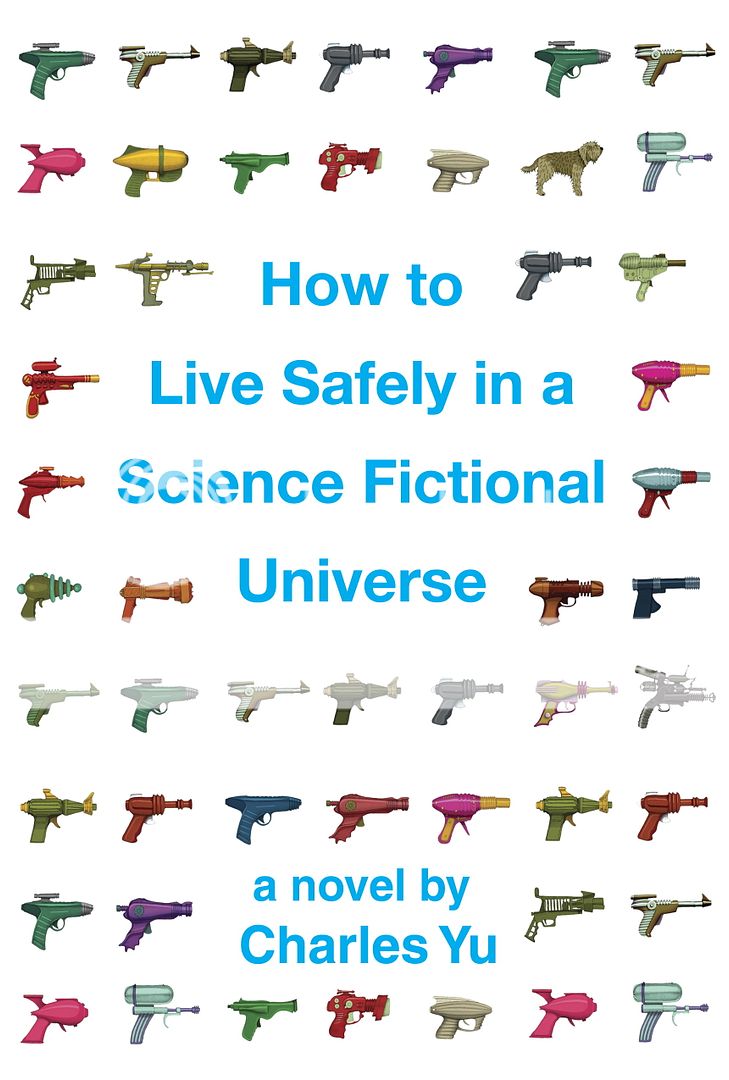
Here at ScriptPhD.com, we love hobnobbing with the scientific and entertainment elite and talking to writers and filmmakers at the top of their craft as much as the next website. But what we love even more is seeking out new talent, the makers of the books, movies and ideas that you’ll be talking about tomorrow, and being proud to be the first to showcase their work. This year, in our preparation for Comic-Con 2010, we ran across such an individual in Charles Yu, whose first novel, How To Live Safely in a Science Fictional Universe premieres this fall, and who spoke about it at a panel over the weekend. We had an opportunity to have lunch with Charles in Los Angeles just prior Comic-Con, and spoke in-depth about his new book, along with the state of sci-fi in current literature. We’re pretty sure Charles Yu is a name science fiction fans are going to be hearing for some time to come. ScriptPhD.com is proud to shine our 2010 Comic-Con spotlight on Charles and his debut novel, which is available September 7, 2010.
How To Live Safely in a Science Fictional Universe is the story of a son searching for his father… through quantum-space time. The story takes place on Minor Universe 31, a vast story-space on the outskirts of fiction, where paradox fluctuates like the stock market, lonely sexbots beckon failed protagonists, and time travel is serious business. Every day, people get into time machines and try to do the one thing they should never do: try to change the past. That’s where the main character, Charles Yu, time travel technician, steps in. Accompanied by TAMMY (who we consider the new Hal), an operating system with low self-esteem, and a nonexistent but ontologically valid dog named Ed, Charles helps save people from themselves. When he’s not on the job, Charles visits his mother (stuck in a one-hour cycle, she makes dinner over and over and over) and searches for his father, who invented time travel and then vanished.
Questions for Charles Yu

ScriptPhD.com: Charles, the story has tremendous traditional sci-fi roots. Can you discuss where the inspiration for this came from?
Charles Yu: Well the sci-fi angle definitely comes from being a kid in the 80s, when there were blockbuster sci-fi things all over the place. I’ve always loved [that time], as a casual fan, but also wanted to write it. I didn’t even start doing that until after I’d graduated from law school. I did write, growing up, but I never wrote fiction—I didn’t think I’d be any good at it! I wrote poetry in college, minored in it, actually. Fiction and poetry are both incredibly hard, and poetry takes more discipline, but at least when I failed in my early writing, it was a 100 words of failure, instead of 5,000 words of it.
SPhD: What were some of your biggest inspirations growing up (television or books) that contributed to your later work?
CY: Definitely The Foundation Trilogy. I remember reading that in the 8th grade, and I remember spending every waking moment reading, because it was the greatest thing I’d ever read. First of all, I was in the 8th grade, so I hadn’t read that many things, but the idea that Asimov created this entire self-contained universe, it was the first time that I’d been exposed to that idea. And then to have this psychohistory on top, it was kind of trippy. Psychohistory is the idea that social sciences can be just as rigorously captured with equations as any physical science. I think that series of books is the main thing that got me into sci-fi.
SPhD: Any regrets about having named the main character after yourself?
CY: Yes. For a very specific reason. People in my life are going to think it’s biographical, which it’s very much not. And it’s very natural for people to do that. And in my first book of short stories, none of the main characters was named after anyone, and still I had family members that asked if that was about our family, or people that gave me great feedback but then said, “How could you do that to your family?” And it was fiction! I don’t think the book could have gotten written had I not left that placeholder in, because the one thing that drove any sort of emotional connection for the story for me was the idea of having less things to worry about. The other thing is that because the main character is named after you, as you’re writing the book, it acts as a fuel or vector to help drive the emotional completion.
SPhD: In the world of your novel, people live in a lachrymose, technologically-driven society. Any commentary therein whatsoever on the technological numbing of our own current culture?
CY: Yes. But I didn’t mean it as a condemnation, in a sense. I wouldn’t make an overt statement about technology and society, but I am more interested in the way that technology can sometimes not connect people, but enable people’s tendency to isolate themselves. Certainly, technology has amazing connective possibilities, but that would have been a much different story, obviously. The emotional plot-level core of this book is a box. And that sort of drove everything from there. The technology is almost an emotional technology that [Charles, the main character] has invented with his dad. It’s a larger reflection of his inability to move past certain limitations that he’s put on himself.
SPhD: What drives Charles, the main character of this book?
CY: What’s really driving Charles emotionally is looking for his dad. But more than that, is trying to move through time, to navigate the past without getting stuck in it.
SPhD: Both of his companions are non-human. Any significance to that?
CY: It probably speaks more to my limitations as a writer [laughs]. That was all part of the lonely guy type that Charles is being portrayed as. If he had a human with him, he’d be a much different person.
SPhD: The book abounds in scientific jargon and technological terminology, which is par for the course in science fiction, but was still very ambitious. Do you have high expectations of the audience that will read this book?
CY: Yeah. I was just reading an interview where the writer essentially said “You can never go wrong by expecting too much [of your audience].” You can definitely go wrong the other way, because that would come off as terrible, or assuming that you know more. But actually, my concerns were more in the other direction, because I knew I was playing fast and loose with concepts that I know I don’t have a great grasp of. I’m writing from the level of amateur who likes reading science books, and studied science in college—an entertainment layreader. My worry was whether I was BSing too much [of the science]. There are parts where it’s clearly fictional science, but there are other parts that I cite things that are real, and is anyone who reads this who actually knows something about science going to say “What the heck is this guy saying?”
SPhD: How To Live… is written in a very atavistic, retro 80s style of science fiction, and really reminded me of the best of Isaac Asimov. How do you feel about the current state of sci-fi literature as relates to your book?
CY: Two really big keys for me, and things I was thinking about while writing [this book], were one, there is kind of a kitchiness to sci-fi, and I think that’s kind of intentional. It has a kind of do-it-yourself aesthetic to it. In my book, you basically have a guy in the garage with his dad, and yes the dad is an engineer, but it’s in a garage without great equipment, so it’s not going to look sleek, you can imagine what it’s going to look like—it’s going to look like something you’d build with things you have lying around in the garage. On the other hand, it is supposed to be this fully realized time machine, and you’re not supposed to be able to imagine it. Even now, when I’m in the library in the science-fiction section, I’ll often look for anthologies that are from the 80s, or the greatest time travel stories from the 20th Century that cover a much greater range of time than what’s being published now. It’s almost like the advancement of real-world technology is edging closer to what used to be the realm of science fiction. The way that I would think about that is that it’s not exploting what the real possibility of science fiction is, which is to explore a current world or any other completely strange world, but not a world totally envisionable ten years from now. You end up speculating on what’s possible or what’s easily extrapollatable from here; that’s not necessarily going to make for super emotional stories.
Charles Yu is a writer and attorney living in Los Angeles, CA.
Last, but certainly not least, is our final Costume of the Day. We chose this young ninja not only because of the coolness of his costume, but because of his quick wit. As we were taking the snapshot he said, “I’m smiling, you just can’t see it.” And a check mate to you, young sir.
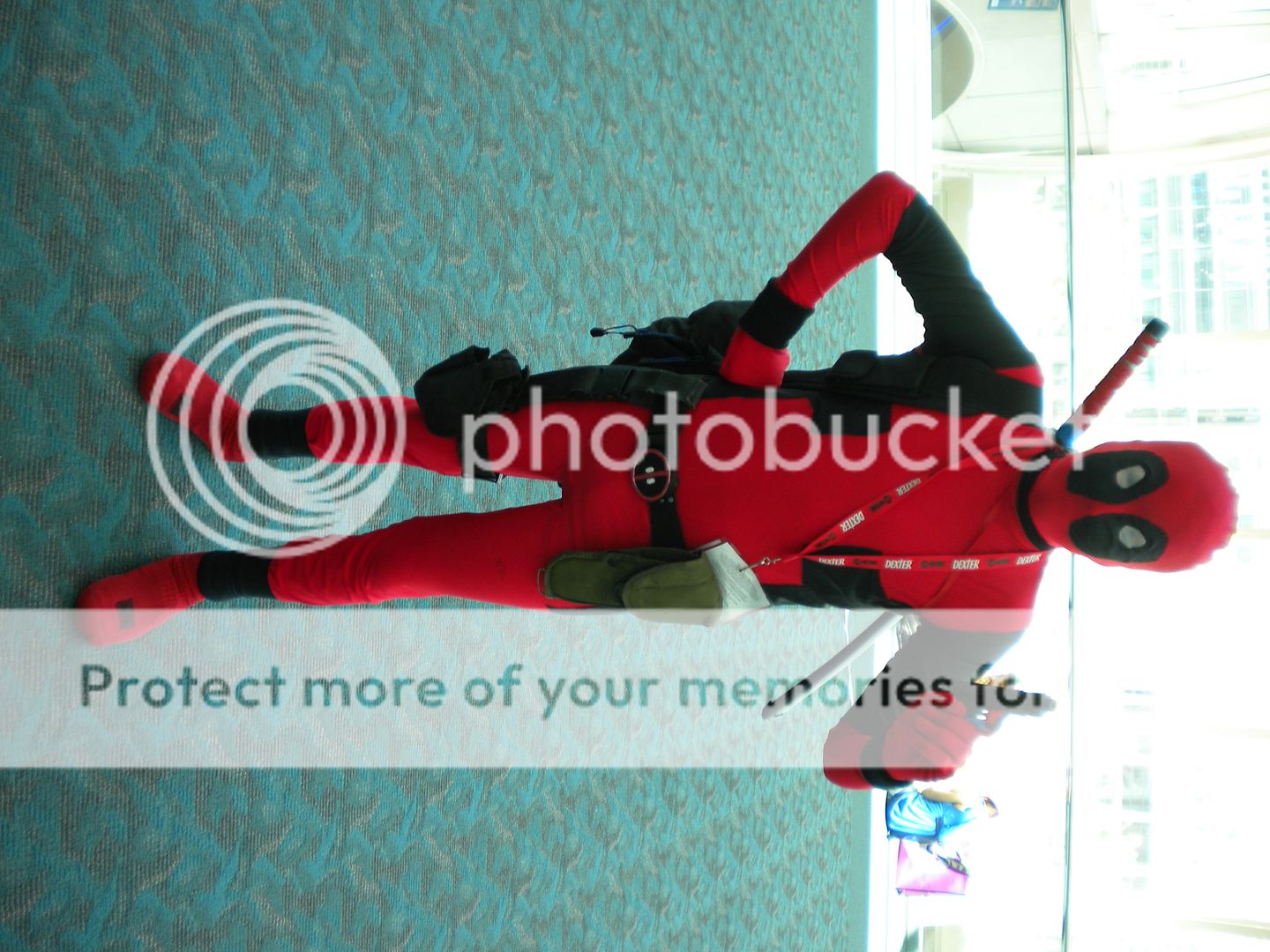
Incidentally, you can find much more photographic coverage of Comic-Con on our Facebook fan page. Become a fan, because this week, we will be announcing Comic-Con swag giveaways that only Facebook fans are eligible for.
~*ScriptPhD*~
*****************
ScriptPhD.com covers science and technology in entertainment, media and advertising. Hire our consulting company for creative content development.
Subscribe to free email notifications of new posts on our home page.
]]>
Day 2 of Comic-Con is over and now, the Convention is really underway! Today’s ScriptPhD.com coverage has a heavy focus on television, and sci-fi television to be specific. Really, is there any other kind? We spent time in the press room with the stars and producers of SyFy Channel hits Caprica and Stargate Universe, our favorite geeky physics show Big Bang Theory and the exciting (first-time ever!) Comic-Con Discovery Channel unveiling of their new scripted series Reign of the Dinosaurs. As always we try to pay hommage to the roots of Comic-Con with coverage of the design tricks behind comics and graphic novels. Additionally, we provide pictorial documentation of the costumes and happenings of the Con, and our Day 2 Costume of the Day. Complete coverage under the “continue reading” cut.
From the Press Room: Stargate Universe
We were delighted to start our day with the cast of one of our favorite sci-fi shows on the air, Stargate Universe, to get a little peek into the cast’s geeky sides and what they think of their characters and show.

For star David Blue, playing the ship’s resident math geek Eli Wallace, this year is a completely different experience. Last year, there was so much uncertainty about the show’s acceptance and success, while this year, the cast walks into Comic-Con confident of where they are headed. He spoke of liking the idea of Eli as a hero, the show’s surrogate for the audience. Though he admits to being a geek, he was very hesitant to play the role when he heard about it, because of his previous computer nerd role on Moonlight for fear of typecasting. But Eli is not a stereotypical nerd, and experiences a lot more emotional and character growth over the course of Season 2. “I am proud to be a geek/nerd,” Blue says. “Everything from computer programming to comic books to video games.”
We were so thrilled to hear that David was a certified Grade A USDA organic geek, that we got him to proclaim so on camera for you guys:

Ming-Na, whose character Camile Wray is far more controversial and decisive on the show, was asked right off the bat what she’d do differently in real life as opposed to her character. “Well, I wouldn’t be a lesbian,” the married actress quipped. Turning more serious, she said that she wouldn’t be as level-headed and calm as her character, who is often asked to make difficult, morally ambiguous decisions based on emotional issues. The fan’s response to Camile is largely a love-hate relationship. She’s gotten great response from the gay community, something that Na appreciates, but Camile’s escape from cliches or stereotypes is something that has resonated. The morally wrenching decisions are a staple of the show (and sci-fi television in general), and will only continue into Season 2. “You may not like her decisions,” says Na, “But I like her.”
From the Press Room: Caprica

One of the most pivotal roles in the history of sci-fi television (the first Cylon) went to a girl that didn’t even really know the significance of the part. “I didn’t know what Battlestar was before I got the role,” admits Torresani, who was not a real sci-fi geek growing up. “I actually turned it down because I didn’t want to do [Caprica]. I wanted to do [Gossip Girl-type fluff]. It’s exciting now to [realize how important the role is], but it wasn’t nerve-wracking at the beginning. When I read the pilot, she was a spoiled brat, and then she gets in a robot. We didn’t know that I was going to be a Cylon. We just thought they’d use my voice and the robot’s body.” Filming the scenes as the Cylon, Torresani revealed, involves acting next to a giant green 7′ tall stick that everyone communicates with as the Cylon. She finds that the hardest part for her as an actress are scenes as the Cylon where she can’t communicate vocally, such as being lit on fire and not being able to utter a single word. “It’s really challenging. That’s something I never thought I’d have to do.”
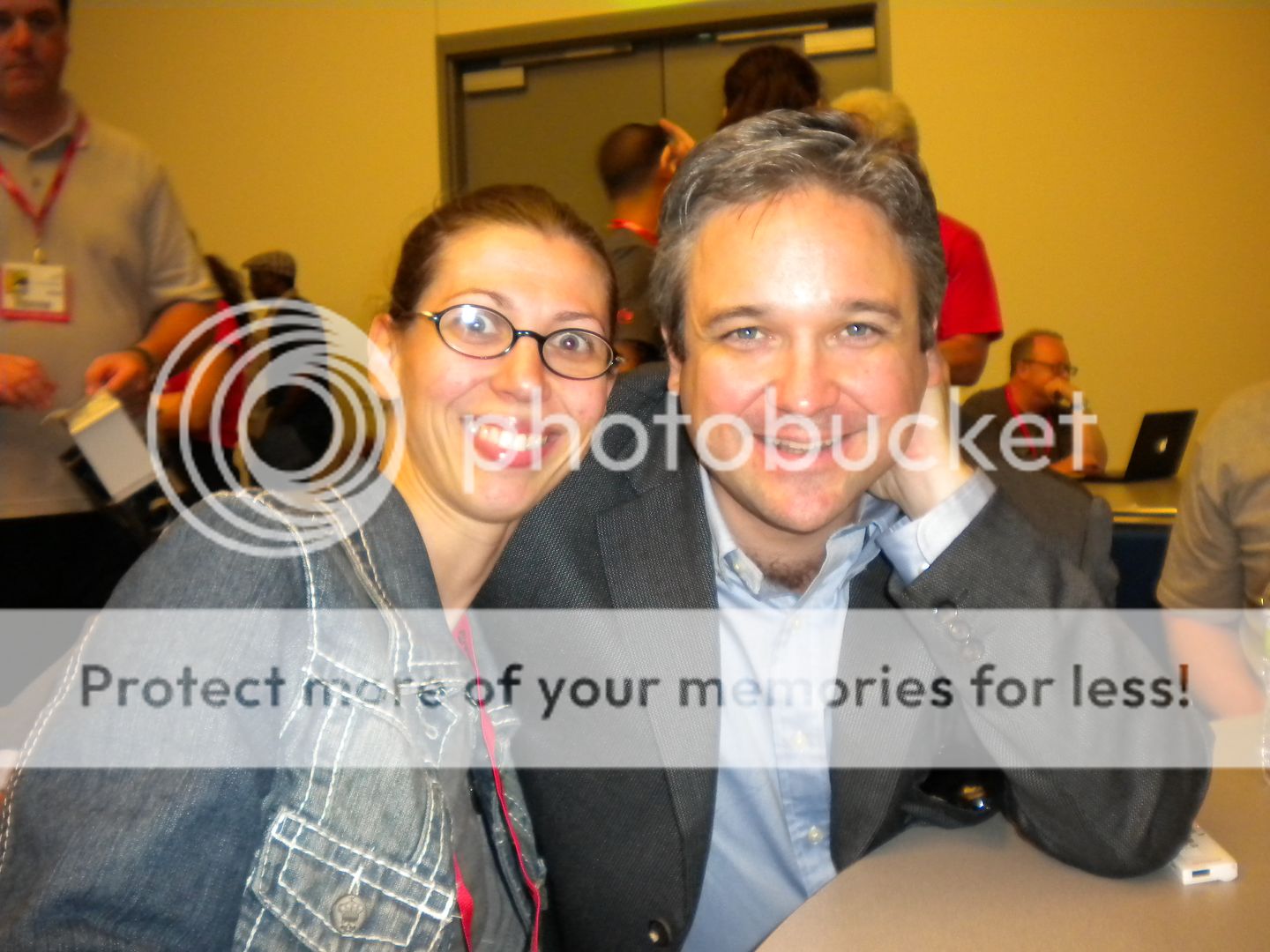
We started our time with executive producer David Eick with a humdinger—the question we know fans would want to ask. What has been the producers’ reaction to mixed reviews and fan division of the show, most notably from the Battlestar Galactica fanbase? “We knew to expect a much greater mix [of opinions] because we knew going in that we were not going to craft it or market it as a spin-off of Battlestar,” replied Eick. Rather than containing cheeky references to BSG or inside jokes only the audience knows, Caprica is very much its own beast. He hopes fervently that as the show finds itself and its own focus, that the audience, too, would find its own way in the show. He reminded us that the early days of Battlestar were equally contentious in terms of critical and fan opinions. “The very first Comic-Con we came to for Battlestar was like George W. Bush showing up at an ACLU rally.”
In many ways, he feels more challenged by Caprica, which lacks the ticking time-clock feel of BSG. It’s a more sophisticated style of storytelling, which is based in defining the characters and the world around then, Rome before the fall. The mythology of that world is deepened as the show progresses, and how it’s harnessed by Zoey to express herself. Eick spoke of how much more graceful and elegant Caprica is visually and content-wise, with Blade Runner being a huge influence on the producers and writers. By contrast, BSG had much more of a Black Hawk Down, action feel to it.
By the way, Ron and David have a longstanding tradition of taking a drink of tequila together before either a major show launch or major seminar/Convention. In fact, David brought the bottle and we all had a little fun. Kidding. But seriously, folks, next time you think the storylines on Caprica are getting a liiiiiiiittle wacky, just remember this picture:

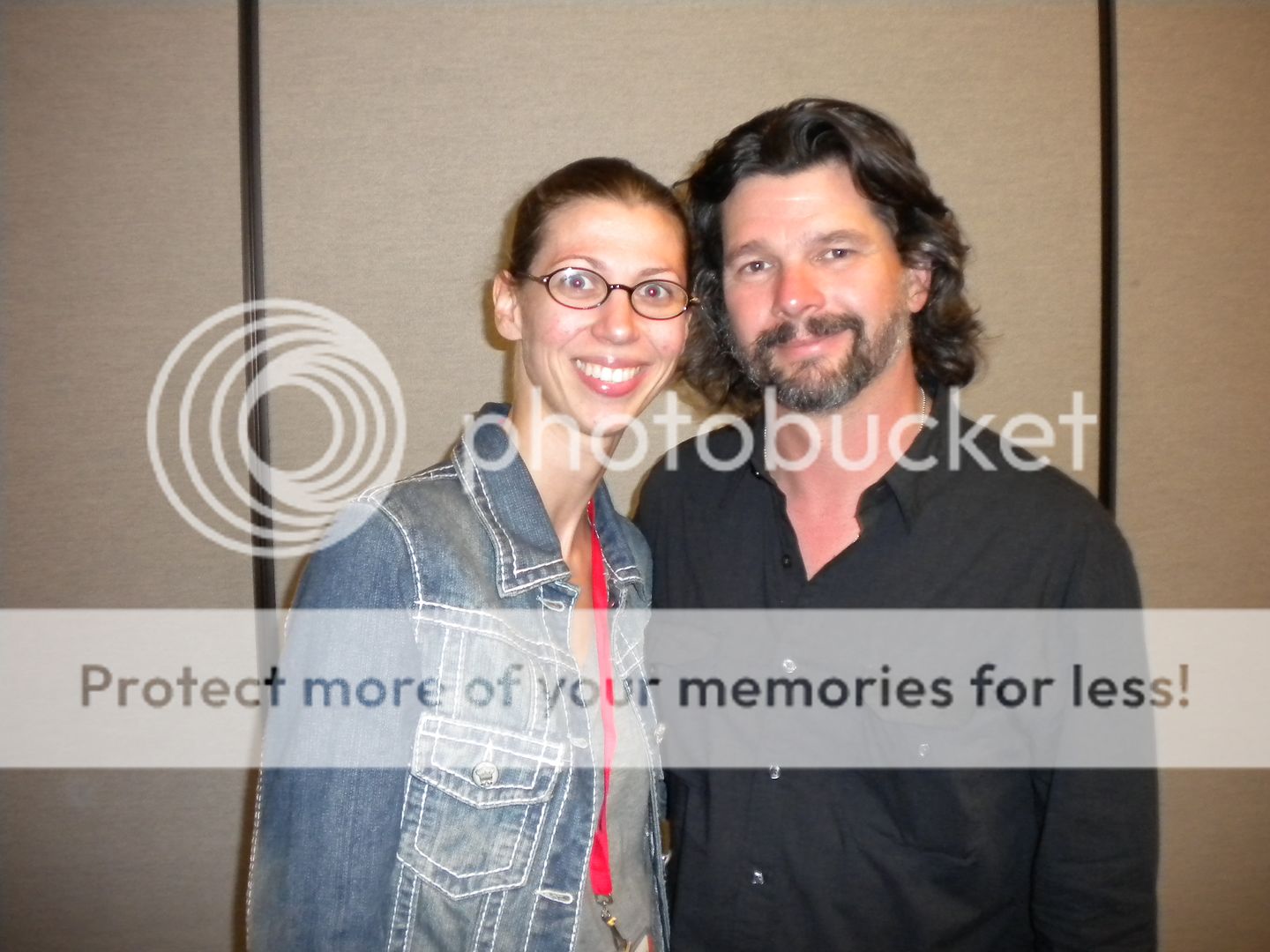
Ronald D. Moore, who made a rare media appearance at Comic-Con this year, largely echoed Eick’s comments. Caprica, he maintained is a serial, and (purposefully) as different from Battlestar Galactica as possible. In an even rarer move, Moore openly self-criticized himself for some of the early hiccups of the show. He admitted that it was hard to follow, that the story was indeed confusing, but that the show gained confidence as it went on. He predicted as strong of a build-up for Caprica as the eventual success of Battlestar Galactica. Another fun tidbit that Moore revealed was that the group marriage concept was tossed around for Battlestar Galactica, but just never found the story or the characters to make it happen.
We asked Ron about his thoughts on the current state of sci-fi and what he enjoys. “I’m probably not up to speed on a lot of other science fiction,” Moore said. “I almost avoid it now because I spend so much of my time in a science fiction world that I tend not to go there. It becomes almost like more work to watch other science fiction shows. In my brain, I’m inevitably thinking ‘How does that compare to us? And that’s their structure. How many characters do they have? I wonder what their CGI budget was.’ I haven’t watched a lot of other science fiction television for that reason.” Nevertheless, he maintains that it’s a thriving genre that will always be with us, despite the rise and fall of popularity. The one holy grail Moore hopes for is a broadcast network (read mainstream) sci-fi hit. He isn’t sure what the reason is that this popularity has remained so elusive, LOST notwithstanding. “Maybe it’s just us,” he mused. “Maybe it’s just us [the collective sci-fi geekdom], and there’s not this gigantic mass market for it in television in the way that there is a gigantic mass market for movies. Maybe that will never happen.”
We here at ScriptPhD.com hope otherwise.
From the Press Room: Big Bang Theory
If Ronald D. Moore is concerned about the viability of a basic network science fiction hit, at least he can take solace in Big Bang Theory, arguably the smartest, most successful, streamlined show about science and scientists in the history of television. We had such a fun time hanging out with the actors last year, that this year, with access to the full production team, we decided to get as much scoop from the show as possible.
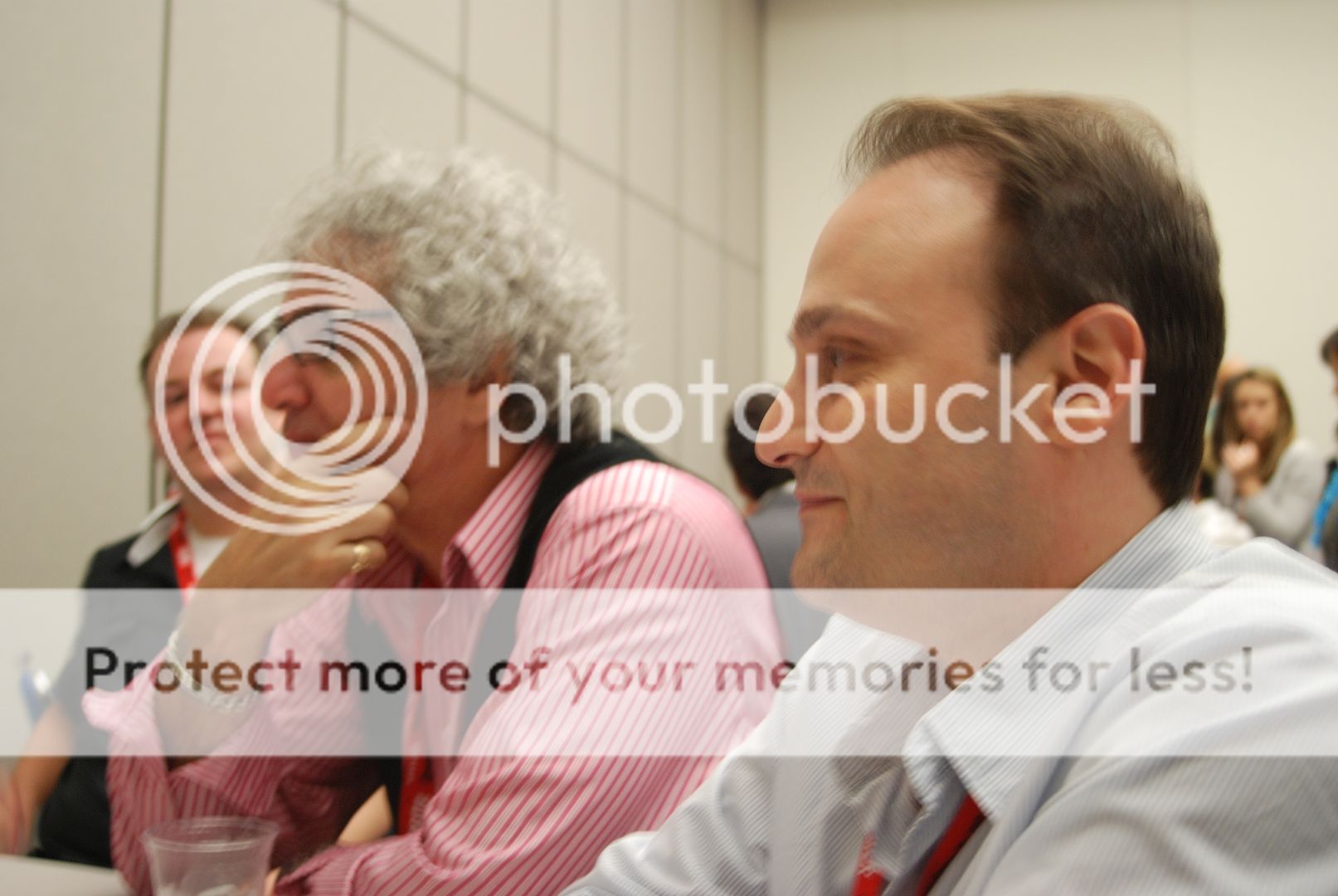

One thing fans would be surprised to learn, and the first question we asked right off the bat, is just how geeky the team behind Big Bang Theory is. Producer/writer Lee Aaronson, a self-certified comics and graphic novel geek, used to own his own comic book store. This is where a lot of the inspiration for Sheldon (and the rest of the team’s) love of geek culture comes from. They also have a close relationship to UCLA physics professor and the show’s science advisor David Salzberg. Often, they will write a line like “Hey guys, I was just working on [insert science here]” and let him fill in the blanks. We were wondering about that, too!
Geeky enough? Not even close. Showrunner and co-creator Bill Prady is a former computer programmer. He’s far more excited about Apple founder Steve Wozniak guest starring on the show than any fame or fortune that has incurred because of it. He and
co-creator Chuck Lorre maintained that the geek culture was their most important singular focus in writing the show. As one might glean from walking the halls of Comic-Con, they maintained that all geeks/nerds/scientists are not the same. There is a lot of heterogeneity amongst them, and differing, personal passions—be they Star Trek or the mathematical concepts behind string theory. And where do they get all their geeky throwaway lines? “Oh, those are all available on the internet!” And THAT is why we love Big Bang Theory.

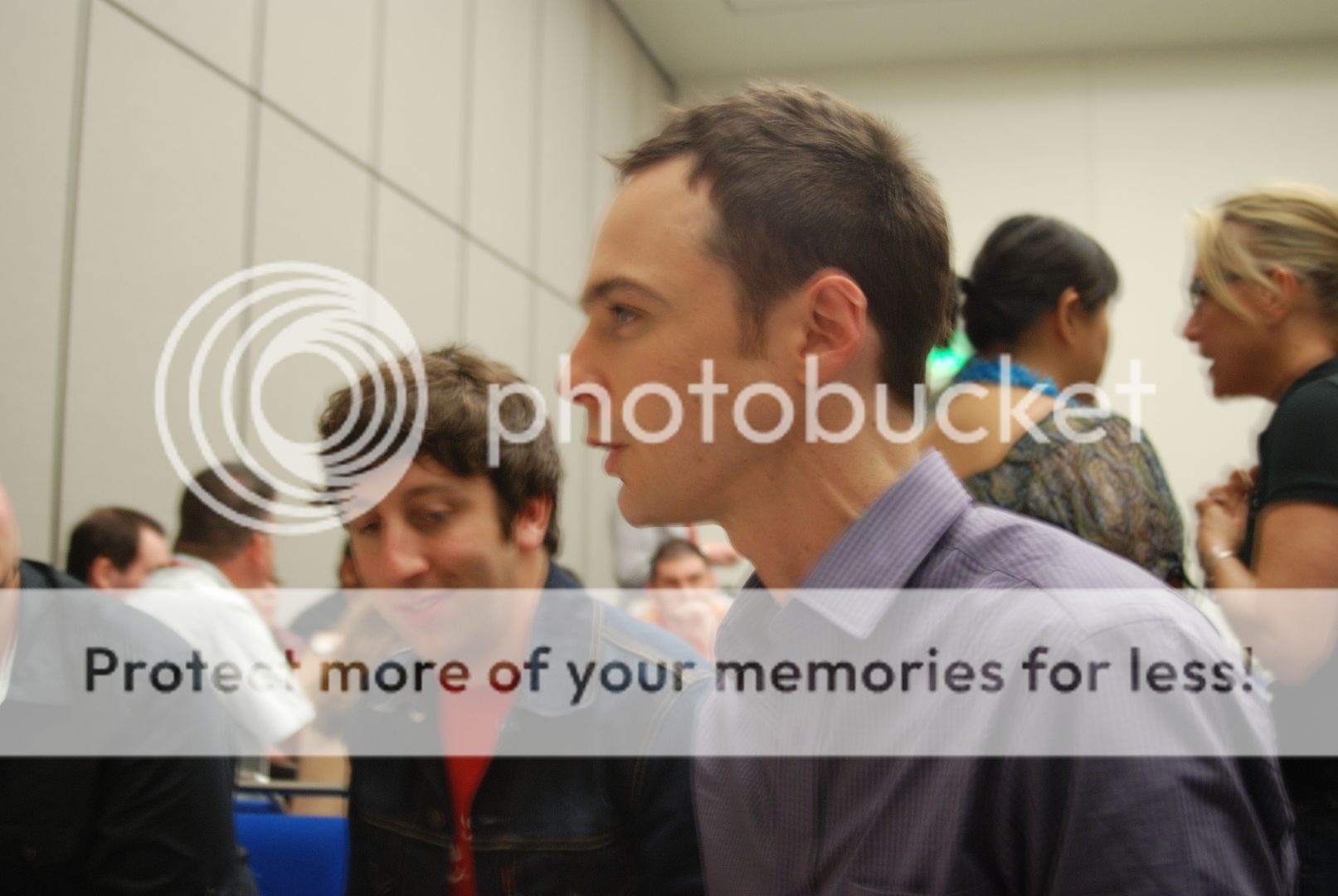
The actors themselves get right in the thick of the fun. Kaley Cuoco, playing perhaps the non-geekiest of the bunch in Penny, has nevertheless embraced geekdom. Her latest love? Her iPad! She and Johnny Galecki would both like to see a romance blossom between Penny and Sheldon (“Peldon,” joked Cuoco), but acknowledge that the road from platonic friendship to romantic involvement is filled with bumps and individual growth. Jim Parsons, who I shamelessly adore, started his time with us by telling me to shove it. He was, of course, talking about my tape recorder, but when I joked that I couldn’t believe Sheldon told me to shove it, his reply was: “And he’d tell you to shove it again and again!” Before telling Simon Helberg to bite him. Nice to know he stays in character so well!
We couldn’t leave a Big Bang Theory press room without getting our favorite superior elitist nerd to do something only for ScriptPhD.com fans. So here you have it, kids. From Jim Parsons, to you… a personal “Bazinga!”
Comics Design

One of THE most fascinating panels that we attended at Comic-Con so far was on the design secrets behind some of your favorite comics and book covers. A panel of some of the world’s leading designers revealed their methodologies (and sometimes failures) in the design process behind their hit pieces. An unparalleled purview into the mind of the designer, and the visual appeal that so often subliminally contributes to the success of a graphic novel, comic, or even regular book. We do, as it turns out, judge books by their covers.
We will be revealing each designer’s comments on their thought and art process, but are waiting for images from the panel to be emailed to us. So consider this a placeholder until we can finish this writeup and include it in Saturday or Sunday’s coverage. Stay tuned . . .
Graphic Novels: The Personal Touch
(From our correspondent Bryy Miller)

Some panels have mysterious names, some not so much. This one belongs in the latter category. There was no hidden meaning behind the phrase “personal touch.” This was all about the writers (Gabrielle Bell of Cecil & Jordan in New York, Howard Cruse of Stuck Rubber Baby, Vanessa Davis of Make Me A Woman, Larry Marder of Beanworld, Jilliam Tamaki of Skim, C. Tyler of You’ll Never Know, and moderator Shaenon Garrity of Skin Horse). More importantly and interestingly, it was about who they were. Some didn’t know who they were, others did, but they all knew one thing: that something inside of them needed to write.
Tamaki started off the discussion by stating perhaps the simplest answer of why she writes what she does, “I think that’s the only kind of book I wanna make.” Davis continued by adding that “anytime… it’s going to have a personal touch. Comics can soak up the people’s idiosyncrasies and sensibilities.” Marder, perhaps the odd man in the group, stated that even though his autobiography is a FANTASY, it still is an autobiography in the sense that it tells stories about his own feelings. Before anyone else could chime in, C. Tyler (arguably the oldest member of the panel) shot to life with an amazing amount of energy and playfulness. “I’ve taken autobiographies for granted.” she started “I know we’re at Comic-Con, but I hate superhero comics. When I read the first autobiographical comic, I was floored… it was disturbing and in a comic.” She went on to describe how she is fascinated with the idea of putting yourself out there, grabbing pieces of scraps from the table and showing us as if they were her life story – or even her creative process – in visual form. She would get extremely animated, and it really helped to humanize the element of the mysterious writer’s block and constant internal struggle to find how to portray your story. She ended her opening remarks with this, “the personal touch for me is I do it all by hand.”
Bell was the most reluctant to speak, but also, besides Tyler, the most visual. Not in the sense that she was very gesticulative or alive, but that she obviously was thinking very hard but having trouble in how to phrase her thoughts. “I try to cut my personal touch out,” she started, displaying the classic writer’s twitch of not looking directly at her audience “[I try to] make it universal. Professional.”
This instigated a very visceral response from Tyler, who on the spot tried to get into an earnest conversation with her fellow comic artist about what it means to be professional. Sadly, it didn’t last that long as Bell migrated back into thought. Cruse then brought up the point that, if your content is good, then mistakes in your craft are easily overlooked by a reader. The discussion (because calling it a panel at the end would just feel weird) had reached its time limit. Cruse gave some parting advice to young writers, “It will literally paralyze you to think of how many people have an idea similar to yours.” Marder stated that you have to fail in public. Garrity reminded everyone to heed that advice, as “Carol, Larry, and Howard have been in the comics since the seventies.”
Tyler let out a self-taunting gag.
Reign of the Dinosaurs

the Dinosaurs creative team (from left to right): Pete Von Sholly, Mishi McCaig,Tom DeRosier, David Krentz, Ricardo Delgado and Iain McCaig. (Executive producer Erik Nelson speaks on the jumbotron.)
In November of 2008, the hoi polloi at Discovery Channel approached producer Erik Nelson (Grizzly Man) with a simple request: “the ultimate kick-ass dinosaur show.” They poured enormous resources, creative and fiduciary, to create a television series that will truly break ground, both for Discovery Channel and its own medium. Scripted, yet unnarrated, scientifically stunning, yet bereft of the omniscient “talking head” paleontologist, Reign of the Dinosaurs is the ultimate exercise in “show don’t tell.” Premiering in the Spring of 2011, Reign will consist of 36 self-contained episodes erected from the art up. The stories will be chronological, detailing the rise, reign, and ultimate extinction (with a twist!) of the dinosaur species. But unlike the plethora of educational shows that cover the same topic, these will be rooted in storytelling, in treating the dinosaurs not as dinosaurs, but characters with whom we share an emotional connection. Trust me, having seen the first few world-premiere clips, you will care for these creatures, and the show will both exhilarate you and break your heart.
The true key to the success of Reign of the Dinosaurs was a dedication to amassing cream of the crop talent, formerly of Disney and Pixar, which allowed them to channel superlative animation and design talents towards an ambitious format. Along with Nelson, the team (and Comic-Con panel) consisted of renowned artists Ricardo Delgado (Dark Horse’s Age of Reptiles), Tom DeRosier (Lilo and Stitch, Mulan), self-proclaimed dinosaur nerd David Krentz (Disney’s Dinosaur, John Carter of Mars), Iain McCaig (Star Wars 1, 2, and 3), Mishi McCaig (Iron Man), Pete Von Sholly (The Mask, Darkman). Along with showing the audience their two (so-far) completed “cold open” teasers that will open episodes of the show, several of the animators simulated storyboard pitches (see picture below), just like the ones they would exchange in a writers’ room for several forthcoming episodes.
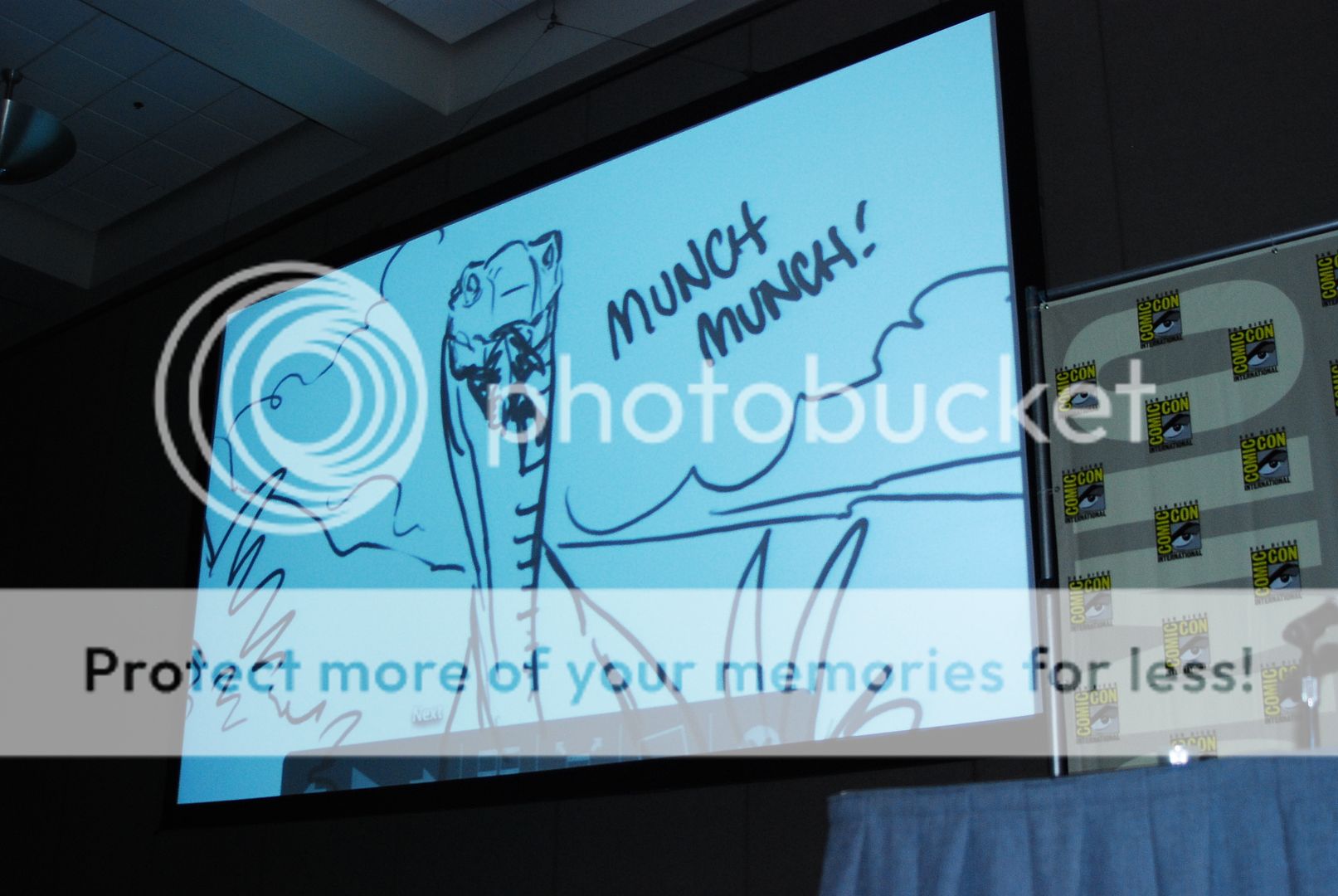
Several things impressed me upon the early viewing of Reign of the Dinosaurs, aside from the stunning art direction and well thought-out design. First of all, this show is really cheeky and funny. When the writers say that they’ll give the creatures personalities, they mean it, and it’s all done through expository action rather than showy narration. An early cold open has a dinosaur, trying to soothe her babies to sleep in the wee hours of the dawn, annoyed at the incessant chirping of a smaller dinosaur deep in the forest. Finally, she marches over and does what a dinosaur would do: bites the head off of her more annoying, diminutive co-habiting pest. Literally. Secondly, the stories pack an emotional wallop. A cinema-quality sequence shown at the end, taking place post-impact of the asteroid that ultimately killed off the dinosaurs, has the post-apocalyptic feel of Cormack McCarthy’s The Road (which the illustrator said influenced him) and visual appeal of Blade Runner. The ending, a hopeful coda on the extinction of the dinosaurs as an evolutionary stepping stone for our modern birds, had me sobbing. And then giving the panel a standing ovation.
Spring of 2011 is far away in television terms, but close enough for me to say this. Be excited, folks. Be very, very excited.
From the Press Room: Reign of the Dinosaurs

Not only did we get treated to a front-row preview of Reign of the Dinosaurs, ScriptPhD.com was extraordinarily fortunate to join the Discovery creative team for an intimate roundtable discussion panel after their panel. We were able to get enormous insight into the team’s collaborative process, storytelling aims, and dedication to balancing scientific accuracy with emotional connection, all while reinventing an entire medium. Ambitious? Just slightly.
One of the first things that impressed me upon talking to the Reign of the Dinosaurs team after their panel was their sheer dedication to, almost obsession with, “getting the science right.” Mishi McCaig and Iain McCaig spoke at length about the team’s dedication to nearing the line between science and entertainment. Hugely important to the project was the involvement of renowned University of Maryland paleontologist Thomas Holz, Jr., who cross-checks and gets pitched all the storyboard ideas. The behavior depicted in the show is speculative, but based on facts. This includes the animal’s muscle movements, how they would hunt prey, how they would interact—all aided by the paleontology knowledge of illustrator Dave Krentz. Ultimately, the team wants interest in the show to launch a more widespread educational initiative, which will include a Discovery multi-media website, and other supplementary materials to the show itself. Even when stories delve into the outrageous or fun, they’re rooted in research. A clip depicting high dinosaurs hallucinating was rooted in the marula tree, whose hallucinogenic fruit animals will eat and get high off of.
Producer Erik Nelson and illustrators Tom DeRosier and Ricardo Delgado spoke at length about the collaborative process of making the show, which they described like a TV writing room, only with animators. “Everyone’s sensibilities came together in a ‘hive mind’,” said Nelson. This visionary approach was important to the team, which is essentially trying to reinvent a TV genre. The last non-narrated, no-dialogue animated show was Walt Disney’s “Silly Symphonies” back in 1938. Needless to say, we’ve come a long way since then. The team was amazed at how constructing the dinosaurs’ stories moved them, comparing their effort to “March of the Penguins,” another simple vehicle showcasing animals that was rooted in an emotional audience response. This empathy for the dinosaurs peaks with the show’s conclusion, in which the dinosaurs die out (spoiler alert!), but which is still painted in an upbeat, survivalist way, as most geologists and paleontologists agree that modern birds are the direct evolutionary ancestors of dinosaurs.
“We’re not trying to hook you as a dinosaur person,” concluded Delgado. “We’re trying to hook you as a human being.”
Two last fun tidbits from today. Last year, on Day 3 of Comic-Con, we got geeky in the press room with our friend Barry of The Ugly Couch Show. When we saw each other again this year, we thought we’d start an annual tradition. So here it is, ladies and gentlemen. Two very tired, cranky, overworked press corps members getting silly in the press room:

And last, but definitely not least, is a very worthy Day 2 Costume of the Day. These ladies hit it out of the park. Bonus points if you can tell us which comics they’re representing:
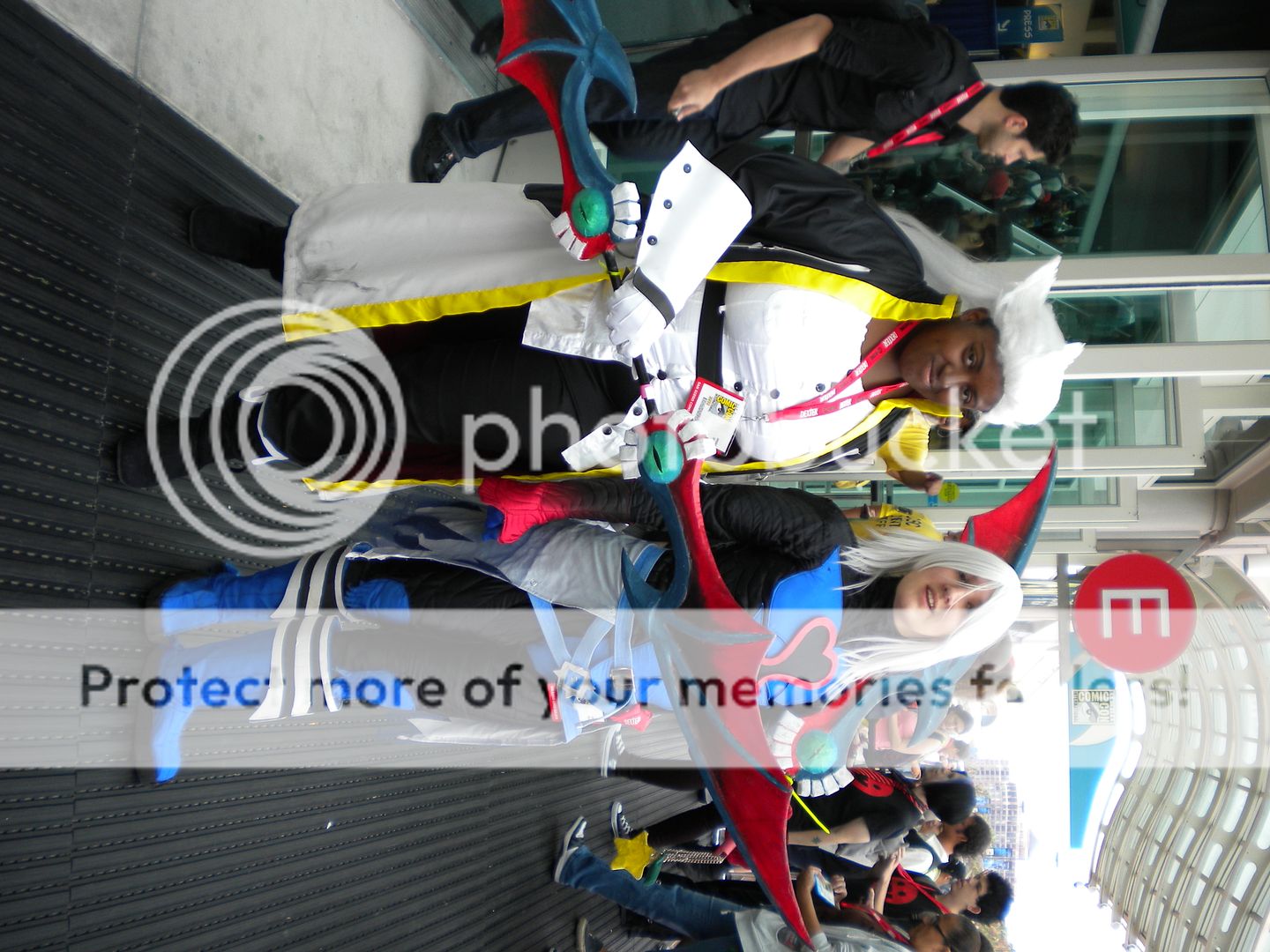
Come back tomorrow for more geeky sci-fi fun! And don’t forget to become a fan of our Facebook fan page for extra Comic-Con photos and a chance to win amazing surprise swag when we get back from San Diego.
~*ScriptPhD*~
*****************
ScriptPhD.com covers science and technology in entertainment, media and advertising. Hire our consulting company for creative content development.
Subscribe to free email notifications of new posts on our home page.
]]>
…a nanoscientist’s quest to mimic Nature’s molecular blueprints
Have you ever found yourself entranced by the exquisite beauty and complexity of living things? Like the intricacies of a budding flower, or the mesmerizing patterns on a butterfly’s wing? Have you ever wondered: “what are living things made of?” Are these materials just as beautiful if we were to zoom way way in and look at the actual molecular building blocks that make up life? Take a look at the interactive link The Scale of Things to see just how small the building blocks of life really are! Well the answer is “OMG – totally!” All living things share a ubiquitous set of molecular building materials we call proteins, and they are absolutely stunning! They are not only smashingly beautiful to look at, they are capable of performing a mind-numbing myriad of very intricate and complex functions that are essential to life. In a very special guest post, leading nanoscience Professor Ron Zuckermann of the renowned Lawrence Berkeley National Laboratory recounts his life’s mission as a chemist to try and build artificial microscale sheets made up of nature’s very own building blocks—proteins. Everything you wanted to know about what nanotechnology is, exactly, why engineering proteins is the science of the future, and what we plan to use these discoveries for, under the “continue reading” cut.
I am a Materials Scientist working in a nanoscience research institute called The Molecular Foundry. A fundamental problem in nanoscience is how to make man-made materials with a similar level of precision and complexity at the molecular level found in nature. I am interested in applying lessons from the world of protein structure to practical man-made materials. If we are successful, we should be able to make materials that are cheap and rugged like a piece of plastic, yet be able to perform highly sophisticated functions, like recognizing a molecular partner with high specificity, or even catalyzing chemical transformations. Such materials could be used to make sensors for the detection of harmful chemicals, or as robust medical diagnostics that could survive harsh conditions, say in an underdeveloped nation. In a nutshell, we aim to make artificial proteins. This is an incredibly difficult problem, and one I have been working on for more than 20 years now. Sound a bit ambitious, or maybe a bit crazy? As I will describe in this article, it may actually be quite possible if we break the problem down into bite size chunks. The challenge comes down to two fundamental things: design and synthesis.

Protein architecture
When I look at the molecular structure of a protein molecule, I see an architectural blueprint that has survived untold generations of evolution and optimization. How then do we break open the hidden rules in these structures and use them to guide us in the design of man-made materials? Over the past several decades, scientists have used the biophysics techniques of X-ray crystallography and nuclear magnetic resonance spectroscopy (NMR) to determine the exact three-dimensional (3D) structure of thousands upon thousands of proteins. What’s cool is that these are all available for anyone to look at (for free!) and study in the Protein Data Bank.
The most fundamental thing to notice is that nearly all protein structures share the following characteristics: (1) they are made of a linear polymer chain that is folded into a precise 3D structure and (2) they are comprised of only 20 simple molecular building blocks called amino acids, arranged in an exact sequence along the polymer chain. When we think of a ‘polymer’ we think of a long chain of repeating chemical building blocks (called monomers) found in materials like nylon or polyethylene. Such man-made materials are incredibly useful and ubiquitous now in our environment (plastic bags or saran wrap, for example). But nature beat us to the punch a long, long time ago. Biopolymers, like proteins and nucleic acids are fundamentally way more sophisticated than man-made polymers. Even though they share the same basic architecture – a linear chain of chemical building blocks – biopolymers contain information encoded in their monomer sequence. This is not unlike the way we store information in a computer. But instead of a long string of 1’s and 0’s, nature uses long polymer chains of either 4 nucleotides (the building block units of RNA and DNA), or 20 amino acids (the building block units of proteins). These 20 chemically distinct amino acid building blocks are arranged in a particular order along the chain that we refer to as the protein’s “sequence.” This sequence is powerful because in many cases it provides all the information or “molecular instructions” necessary for the polymer chain to fold up into a precisely defined 3-dimensional structure. Once folded, the protein is poised and ready for action. The fields of Structural Biology and Protein Folding have revealed the exact way that proteins fold to form local “secondary” structures, called alpha helices and beta sheets, and how these assemble together to create the fully folded protein structure. Think all this sounds a bit too complicate? Try visiting FoldIt, a really fun video game where you can actually learn all about protein folding!
Protein Mimicry
If we ever hope to create man-made protein-like materials, it is safe to assume that we will need a polymer system that shares some of the basic protein-like characteristics: for example, they will need to have a sizable set of chemically diverse monomer building blocks that can be arranged in a particular order along a linear polymer chain of at least 50 monomers long. This is a quite a tall order simply from a chemical synthesis perspective. Moreover, once we are over that hurdle, design tools will be needed to help us figure out which sequences to make.
In the early 1990s, I invented a way to synthesize a new family of non-natural polymers we called “peptoids.” I had just graduated from UC Berkeley with a PhD in organic chemistry and joined a start-up biotechnology company to develop new technologies to accelerate drug discovery. We developed peptoids to be potential therapeutic drugs. The cool thing about peptoids is that the building blocks are very very close in structure to Nature’s amino acids, but different enough to be much more rugged. They can be made from very cheap and simple chemical building blocks, and they can be made in any predetermined sequence you want. We soon developed robotic synthesizers to automatically synthesize these materials for us (see below).

Before long we discovered that short peptoid chains (just 3 monomers long) could have potent biological activities and showed promise as drug candidates. But what really floored me was that the peptoid synthesis chemistry we developed worked so efficiently that we could link over 50 monomers together, one after the other. This means each building block was being attached to a growing chain with an incredible accuracy of over 99.5%! This was exactly the tool we needed to begin the quest for creating artificial proteins. We had discovered the most efficient and practical way to make non-natural polymers of a specific sequence. This was completely awesome!
There was only one problem – the company I worked for had no interest in such a bold quest into basic science. How could such a pursuit lead to a moneymaking product in a few months? In 2006 I moved to Lawrence Berkeley National Laboratory where I set out in earnest to search for artificial proteins. Fortunately, tackling difficult problems in basic science is much more the norm here. And more good news – my previous employer was kind enough to donate my robots to me. Armed with this technology to synthesize peptoid polymers, we turned to the next daunting task: which sequence of monomers should we make? It turns out that there are an absolutely astronomical number of possible peptoid sequences that can be made. Consider that there are several hundred building blocks to choose from at each of the 50 positions of a polymer chain. This means there are over 100 to the 50th power potential sequences to choose from. This is more than the number of atoms in the universe! What was a chemist to do?
Like Oil and Water
To help us focus our sequence design, we once again turned to nature. A long-time collaborator and friend of mine, Professor Ken Dill of UC San Francisco has studied protein structure in detail for decades, and has distilled some fundamental rules that are universal to all protein structures. He notes that protein structures are like globes with a water-loving surface and a water-hating (or oil-like) interior. The bottom line is you can basically lump each amino acid in the protein’s sequence into one of two categories: oil-like or water-like. This simple classification can tell you whether an amino acid is located on the inside or the outside of the protein.
The amazing thing about this insight is that it’s like looking at a protein wearing X-ray glasses! Instead of seeing 20 different “colors” of amino acids, we see only two: black and white. We are back to a simple binary code—like 1’s and 0’s. This makes it much easier to see the secret patterns hidden within the sequence. In fact, many researches have convincingly demonstrated that these binary patterns are simple, plentiful and predictable.
So with our handy X-ray glasses on we returned our gaze to the peptoid structure problem. We realized that all our sequence recipe needed was a touch of Dill! This meant we could greatly simplify our search for the right peptoid sequence. We needed to only consider two, diametrically opposed building blocks: water loving and water hating.
Nanosheets
Inspired by these insights, we set out to find the right sequence patterns that would result in a precisely ordered structure in a non-natural peptoid polymer. We began to systematically unlock the sequence code by using our robots to synthesize all the possible repeating patterns of these two disparate building blocks. We reasoned that if we were to make something precisely ordered, it would “crystallize” into something that we could see. Fortunately we have really powerful electron microscopes in my building. So we started cranking through all the possible sequence patterns, dissolving up each new sequence in some water and taking it down to the basement to look at them really close up.
Now it is a little nuts to think that we could make something precisely structured from a peptoid polymer, since it is known that each strand is about as stiff as a piece of overcooked spaghetti. And as one might expect, most of our sequences looked really messy and gooey. But very soon we saw something quite striking. In one particular sample, we saw large, flat paper-like objects with sharp, straight edges. And they were floating around everywhere in the solution. An unexpected sight to be sure!

Fast-forward another year of making careful measurements and reproducing the results over and over. We determined that these sheets were only two molecules thick, and yet millions and millions of molecules wide. We had discovered the largest and thinnest organic crystals ever! We were able to use one of the most powerful electron microscopes in the world in the National Center of Electron Microscopy, to look directly at the individual polymer chains that make up the crystal. We could see these chains wiggle around and slide against one another as if they were alive. No one had ever seen such detail before – a truly awe-inspiring sight!
We were able to use many kinds of advanced analytical tools to tell us that these nanosheets were indeed very special. They have the same kind of ordered structure that a protein has: they have a defined inside and outside, and we know almost exactly where each atom is located in the structure. Essentially, we discovered the sequence code that programs the polymer chain to form a 2D sheet. No doubt there are more complex codes waiting to be discovered that will form even more sophisticated structures. This discovery was recently reported in the journal Nature Materials, and was picked up by the more mainstream publications WIRED.com and Chemical & Engineering News. These sheets are likely to be important for all kinds of potential applications. Their discovery is kind of like the invention of ‘molecular plywood’: a new kind of nanoscale building material from which we can engineer even more complex molecular architectures. It’s amazing what kind of beauty you can create from simple building blocks!
Basic research like this can move seemingly very slowly, which makes the occasional breakthrough like this all the more meaningful and exciting. It reaffirms for me that it is so important to listen to and cultivate your inner curiosity, surround yourself with like-minded people, and aim high. With enough patience and persistence, wonderful things await discovery!
Take a look at a brief video of Dr. Zuckermann explaining his lab’s nanosheet discovery:
Ron Zuckermann is the Facility Director of the Biological Nanostructures Facility at Lawrence Berkeley Laboratory. Dr. Zuckerman also provides numerous consulting services at the intersection of chemistry, biology and engineering.
*****************
ScriptPhD.com covers science and technology in entertainment, media and advertising. Hire our consulting company for creative content development.
Subscribe to free email notifications of new posts on our home page.
]]>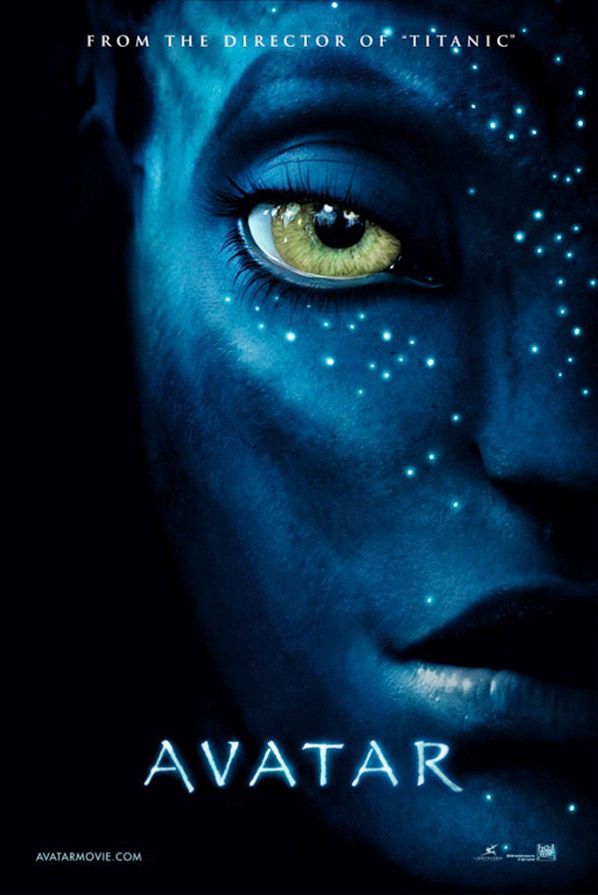
There are certain films that outlive their theatrical releases to become evolutionary stepping stones of filmmaking. Long after the popcorn has been munched and the Oscars handed out, these movies stand the test of time and usher in the cinematic equivalents of geologic Eras. D.W. Griffith’s The Birth of a Nation redefined the beauty of silent imagery. Alan Crosland’s The Jazz Singer integrated sound and heralded the rise of “the talkie.” Orson Welles’s Citizen Kane became a hallmark of big-budget studio genius. And every sci-fi film of the last forty years owes debt to the standard set by Stanley Kubrick’s 2001: A Space Odyssey. And then there is Avatar. That this film, with fifteen years of creative development, four years of full-time work, and endless hype, was bound to be good seems like manifest destiny. But it doesn’t just live up to its hype—it exceeds it. James Cameron has reinvented visual possibilities, perfected multi-layered storytelling and provided a service to audiences and filmmakers. He has transitioned us into the next big cinematic Era: 3D. Avatar is a ScriptPhD.com Editor’s Selection. For a full review, please click “continue reading”.
REVIEW: Avatar
ScriptPhD.com Grade: A+ (Editor’s Selection)
The year is 2154. The Earth has long been pillaged of its resources and habitability. Looking to solve this impending energy crisis, a human colony has been mining for the valuable mineral ‘unobtanium’ for three decades on Pandora, a distant Moon of the Alpha Centauri-A star system. At 4.4 billion light years away, travel to Pandora requires six years of arduous travel in cryogenic hibernation. Although possessing an Earth-like environment, Pandora’s atmosphere is toxic. Furthermore, native denizens, a humanoid Na’avi tribe, present a direct threat to humans, due both to their advanced biomechanical structure and animosity towards their occupiers’ fixations on what they feel is their sacred native land. In order to explore the territory safely, human being “drivers” must virtually connect their consciousness to a physical avatar hybrid composed of 50% human DNA and 50% Na’avi DNA. Referred to pejoratively by the Na’avi as “the sky people,” human imperialists become increasingly aggressive about destroying native territory to harvest ‘unobtainium,’ leading to perilous tensions between the two groups and the brink of all-out war.
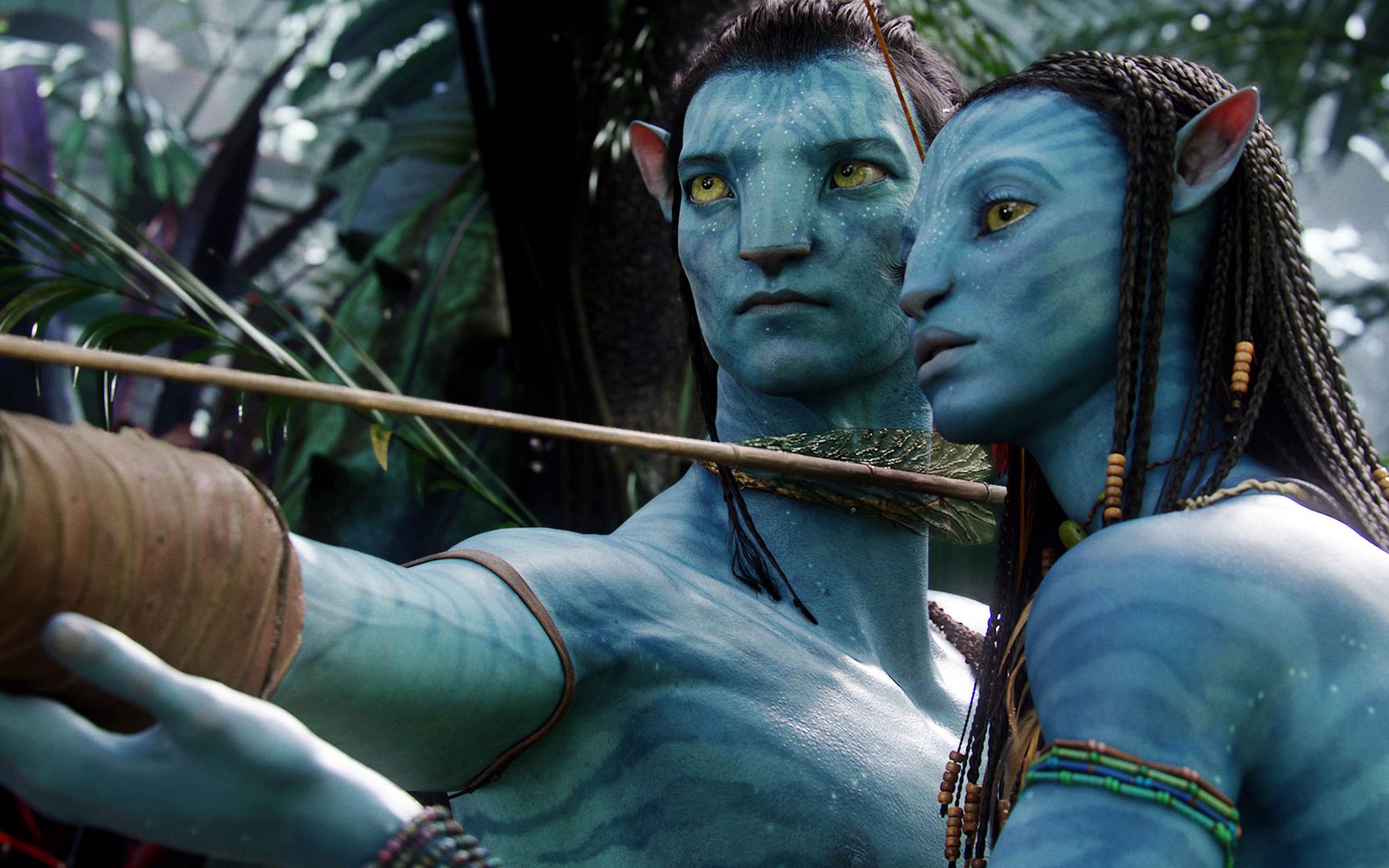
Enter Jake Sully (Sam Worthington), an accidental everyman hero and paraplegic ex-Marine. No doubt an ode to Cameron’s own brother John David, who served in the first Gulf War and even helped train Worthington for the role, Sully is lacking in mobility but still a warrior at heart. After the death of his twin brother, a scientist at the Avatar Program, Sully is the only one whose DNA matches and can drive his brother’s Na’avi avatar. Overly eager to use his new virtual body, Jake gets trapped on Pandora and saved by the beautiful Princess Neytari (Zoë Saldana). Far from viewing him favorably, she can’t ignore an auspicious sign from the Na’avi deity Eywah that Jake must become one of them and learn their ways. This is music to the ears of chain-smoking tough-as-nails head scientist Dr. Grace Augustine (Sigourney Weaver, flawless), who sees this as an opportunity to study the Na’avi in an unprecedented way. Colonel Miles Quatrich, a despotic Rambo played with jingoistic abandon by Stephen Lang, recruits Sully as special ops to learn the Na’avi weaknesses and where they may be infiltrated. Mediating the two camps is Resources Development Administration agent Parker Selfridge (Giovanni Ribisi), an insipid corporate monger who will work with whichever side leads to the ‘unobtainium.’ The scientists’ interests are purely the biology of Pandora and forging diplomacy with its peoples, the military to wield might (shock and awe, anyone?), and the RDA to make as much money as possible. Jake is caught between arbitrating these opposing human interests as he connects spiritually with the natural beauty of Pandora and falls in love with Neytiri. He must choose which side he will fight for and where his loyalties lie.
We have already written extensively earlier this week about the scientific and technological breakthroughs in the making of Avatar in our post entitled Behind Avatar: Science, Technology, Art and Design. This review is primarily concerned with its artistic achievements, which are significant. While some of Cameron’s derivative dialogue is a consistent weakness in his screenplays, he makes up for it with rich characters and familiar archetypes, particularly his trademark strong woman (in this case fulfilled dually by Weaver’s Augustine and Saldana’s Neytiri). Augustine is the kind of knowledgeable, authoritative female scientist we wish would get portrayed in mainstream film, and is equal parts firm with the inexperienced non-scientist as she is empathetic with his journey to Na’avi manhood. Neytiri is an exceptionally complex female lead, and a big credit to Saldana for a nuanced performance filmed in a virtually empty box. Neytiri teaches Jake to hunt, survive, and roam the treacherous land with a strong hand, but opens his eyes to where the true sacred wealth of her world lies—in respect for the Earth, the animals, the spirit and the biology, not what lies in the ground. Rounding out the cast are terrific CCH Pounder as Moat, Neytiri’s mother and Na’avi matriarch, Michelle Rodriguez as the rogue helicopter pilot Trudy Chacon (whose conscience leads to a very important role towards the end of the film), and Joel David Moore as über-nerdy scientist Norm Spellman, Jake’s Na’avi language coach.
The highlight of Avatar, and the price of admission, is the surreal beauty of the viewing experience and CGI melded seamlessly with live-action sequences shot in stereoscopic 3D. Cameron’s genius directing avoids the over-the-top action of Terminator or melodrama of Titanic to let the surroundings play a key role, if not the major role, in the film. He went to great lengths to create a unique flora and fauna for Pandora and he lets them shine. Nighttime scenes shot in bioluminescent forests, each footstep lighting a path on mystical trees, collapsing flowers, fluorescent foliage, fruit of impossibly vivid color, are nothing short of magical. Certain panoramic shots or flying sequences transported The ScriptPhD to childlike wonder, slack-jawed and only capable of a primitive ooooooh or ahhhhhhhh. Animals, eliciting enormous respect in the Na’avi culture, are at the epicenter of this film. The entire ark of Cameron’s creations, ranging from the most powerful Tyrannosaurus-like behemoth to the most delicate winged creature, is designed with precision and detail. By far the most critical of these is the banshee, a dragon-horse-eagle hybrid that must be tamed individually by each Na’avi before being adopted as a flying vehicle. Technical prowess in the penultimate human-Na’avi and banshee-military vehicle battle sequences are near perfection and can easily vie with the most beloved war movies of all time. So put on your 3D glasses, sit back, and prepare yourselves to be transported to an unimaginable universe.
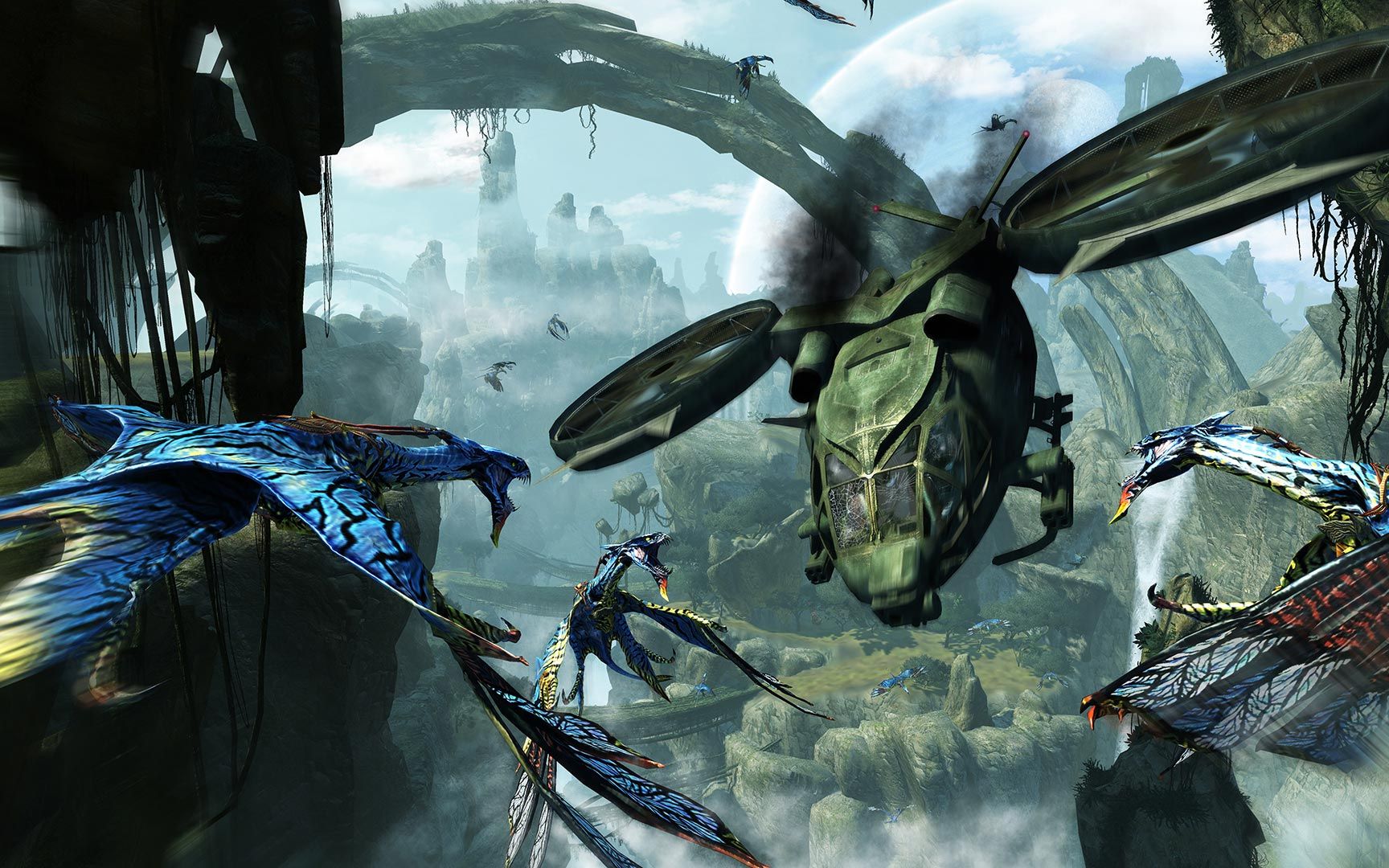
Avatar is a modern film that smartly tackles many of the moral and academic quandaries we struggle with as a 21st Century society, including the environment, resource management, conflict, global imperialism and corporate greed. It sets new technology standards in digital animation and CGI. But it’s also a pure love story, an old-fashioned sci-fi thriller, an adventure and a centuries-old fable about acceptance, alienation and connection. “I wanted to create a familiar type of adventure in an unfamiliar environment by setting the classic tale of a newcomer to a foreign land and culture on an alien planet,” Cameron said. “The story is by design classic in its broad strokes, but we have plenty of twists and turns in store for the audience. I’ve dreamed of creating a film like this, set on another world of great danger and beauty, since I was a kid reading pulp science fiction and comic books by the truckload, and sitting in math class drawing creatures and aliens behind my propped up
textbook.” We are all grateful beneficiaries of the realization of his dream.
Avatar Trailer:
Avatar goes into wide release in IMAX and theaters nationwide on December 15, 2009.
~*ScriptPhD*~
*****************
ScriptPhD.com covers science and technology in entertainment, media and advertising. Hire our consulting company for creative content development.
Subscribe to free email notifications of new posts on our home page.
]]>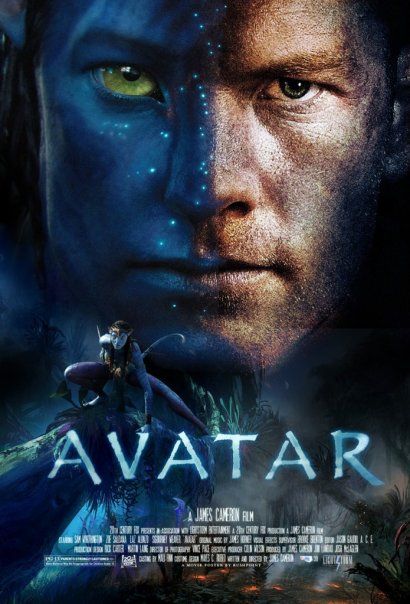
This weekend, millions of people will flock to IMAX theaters and cinemas around the world, 3-D glasses eagerly perched, in anticipation of James Cameron’s masterpiece Avatar, a cinematic œuvre fifteen years in the making. Underscoring this two and a half our epic lie unparalleled technological, scientific and artistic achievements, including the invention of a novel 3-D film camera, the complete biological and linguistic realization of a virtual world, and flawlessly integrated art direction and conceptual renderings. Many people’s post-viewing reaction will be, “How did they do that?!” ScriptPhD.com is proud to present a special Avatar preview that includes behind-the-scenes secrets and a review of the must-own companion design book The Art of Avatar. Before you see the movie, get to know it.
Fresh off of astronomical success with Titanic—11 Oscars and the highest-grossing revenue of all time—James Cameron could have done anything. He was King of the World, remember? Any film, any project, the sky was the limit. Instead, he disappeared, only to reemerge in 2005 to propose a new big-budget blockbuster to 20th Century Fox. They funded a $10 million 5-minute prototype for Avatar, but hesitated green-lighting full production, citing the 153-page script (first conceived in 1995), ambitious new video technology, and a story producers feared would alienate audiences. Only when Disney expressed interest in the film did they give Cameron a full go-ahead. The result is a movie with a final budget of over $230 million that required four years’ of full-time work to complete. Avatar is a sweeping epic that takes place on fictitious Pandora, a distant moon in the Alpha Centauri-A star system that has been colonized by humans in the year 2154. Discovery of an abundant precious ore, unobtanium, that might solve Earth’s energy crisis leads corporate and military interests to infiltrate the ranks of a native population of humanoids called the Na’avi. Because of a toxic atmosphere, human “drivers” link their consciousness to genetically engineered avatar models—50% human DNA, 50% Na’avi DNA. Jake Sully, a paraplegic ex-Marine, has been called to take his dead brother’s place for scientific exploration of Pandora’s ecosystem, biosphere and indigenous peoples. Inadvertently enveloped into learning the Na’avi culture and ways, Jake soon falls in love with the Princess Neytari and becomes caught in a battle between his own people and the virtual world he has adopted. Avatar, however, transcends whatever story or theme one imagines to define it. It is a pinnacle of scientific and technological innovation, an ode to its filmmaker’s vast travels (earthly and underwater) and intergalactic fascinations, and a harbinger of a filmmaking style that will redefine 21st Century cinema. “This film integrates my life’s achievements,” Cameron said in a New Yorker profile earlier this fall. “It’s the most complicated stuff anyone’s ever done.”
The Technology
•Performance Capture
Motion capture and computer-generated imagery (CGI) are not new to film. Motion capture (or green screen technology) was first introduced by Cameron for Total Recall, with the first CGI human movements added later for Terminator 2. It is, however, inherently limiting to the size and proportions of the human body, in particular the actor of the character being portrayed. The eyes can’t be moved, for example, and makeup often inhibits actor performance. CGI is traditionally done by placing reflective markers all over an actor’s face and body, which are then interpreted by computer technology to create digitized expressions for the CG character. However, the gulf between human and CG expression, referred to as the “uncanny valley”, is often quite noticeable. To bridge the two and create the first truly seamless hybridized CGI, Cameron and his team developed a new “image-based facial performance capture”, requiring the actors to wear special headgear rig equipped with a camera. With cameras placed just inches from their face, actors’ every muscle contraction or pupil dilation was captured and digitized, creating astounding emotional authenticity to their Na’avi avatar counterparts. “If Madonna can be bouncing around with a microphone in her face and give a great performance,” Producer Jon Landau said in a New York Times interview, “we thought, ‘Let’s replace that microphone with a video camera.’ That video camera stays with the actor while we’re capturing the performance, and while we don’t use that image itself, we give it to the visual-effects company and they render it in a frame-by frame, almost pore-by-pore level.” The scope of clarity and precision of the head-rig allowed for a much larger capture environment than ever before, a bare stage called the “Volume”, six times larger than any previous capture environment.
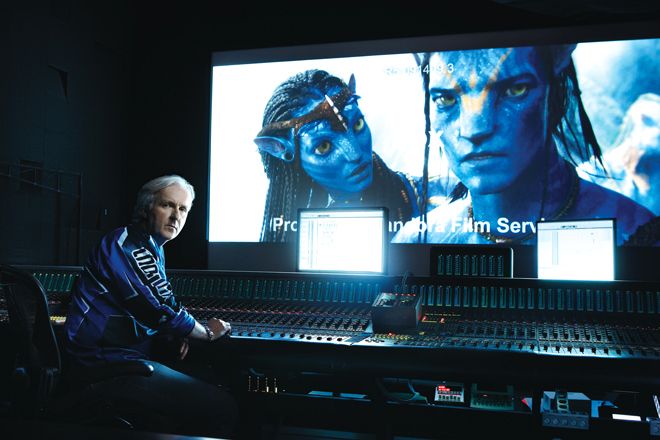
•Digital animation
State-of-the-art animation renderings for Avatar were done by Peter Jackson’s New Zealand-based digital-effects studio Weta Digital. A team of talented artists transferred basic renderings (more on this below) into photo-real images, particularly using new breakthroughs in lighting, shading, and rendering. “I’ve seen people looking at Avatar shots, being convinced they are somehow looking at actors in makeup,” Jackson says. The realism was extended to each leaf, tree, plant and rock, which were rendered in WETA computers. Additionally, a team of artists, headed by Academy Award winner Richard Taylor, designed the props and weapons for the Na’avi and humans. All of this digital design took over one year to complete and took up over a petabyte, one thousand terabytes, of hard drive space!

•Stereoscopic 3D Fusion Camera System
As far back as ten years ago, James Cameron had wanted to develop a 3D camera. At that time, the concerted goal was to use it to shoot a gritty Mars movie that would act as an emblem for space exploration (Cameron is on the advisory board of NASA). At this time, stereoscopic 3D cameras were the size of washing machines and weighed 450 pounds. The challenge issued to production partner Vince Pace was to develop a lightweight, quiet camera capable of shooting in both 2D and 3D. The result of over seven years of hard work was the groundbreaking new Fusion Camera System, the world’s most advanced 3D camera. It facilitated an almost flawless merger between live action scenes and CG scenes. Most of the live-action scenes were shot in Wellington, New Zealand on sets constructed by a massive team of 150 contractors. Live-action sets included the link rooms (where the humans transported to their Na’avi avatars, the Bio-Lab, the Ops Center military operations area, and the Armor Bay military stronghold, which housed all the weapons and transport units.
•Virtual Camera/Simul-Cam
Tying together the 3D and CG technology of visualizing the film were two new Cameron intermediary inventions: the virtual camera and the simul-cam. The virtual camera, used by Cameron in the Volume motion capture stage, wasn’t actually a camera at all. Looking like a video game controller, it simulated a camera that was fed CG images by supercomputers surrounding the Volume. This allowed amplification of each small adjustment on the virtual production stage, from camera movement to actor interaction, to gauge the overall effect on the final big-screen cut. The simul-cam fed, in integrated real-time, CG characters and environments into the live action Fusion 3D camera eyepiece, allowing Cameron to direct virtual scenes on Pandora the same way he would a live-action scene.
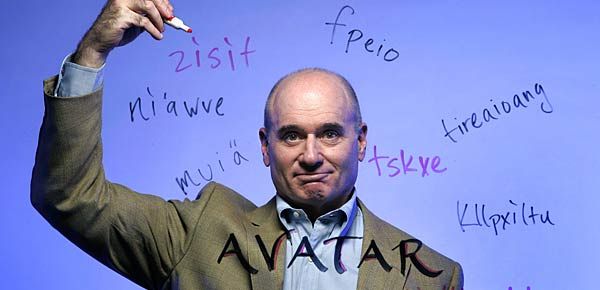
The Language
Not satisfied with merely creating an otherworldly planet and its native beings from scratch, James Cameron set about equipping the Na’avi humanoid tribe with a language of their own. Audiences will be delighted in the authenticity—all communication on Pandora is shown through subtitles befitting a foreign film. Ever the mindful scientist, Cameron hired USC professor and linguist Dr. Paul Frommer to engineer the dialect from scratch, resulting in a respectable, self-sufficient vocabulary of about a thousand words bound by a consistent sound system, grammar, orthography, and syntax. In an extensive interview with Vanity Fair, Dr. Frommer says that Cameron approached him as far back as 2005, when Avatar was going by a code name of Project 880. As with every other aspect of this film, Cameron’s genius micromanagement provided Dr. Frommer with the basics of the sound and structure he was looking for. “I didn’t start from absolute ground zero,” said Frommer, “Because James Cameron had come up with, in the early script, maybe 30 words. Most of them were character names, but there were a couple of names of animals. So at that point I had a sense of some of the sounds that he had in his ear and it reminded me a little bit of some Polynesian languages.”
In addition to painstakingly working on the syntax for over five years, which he compiled into a pamphlet entitled Speak Na’avi, Dr. Frommer worked closely on-set with Avatar actors to ensure proper pronunciation and phonetic differences between native Na’avi speakers, and their human avatar contrasts. Beyond the film, Dr. Frommer is not done developing Na’avi, in the hopes that it might take off like Klingon did post-Star Trek. “I’m still working and I hope that the language will have a life of its own,” the professor said in an interview with the Los Angeles Times. “For one thing, I’m hoping there will be prequels and sequels to the film, which means more language will be needed. I spent three weeks in May, too, working on the [Avatar] video game for Ubisoft, which is the name of a French company.” (The Hollywood Reporter recently posted a terrific interactive preview of the video game.)
The Science
A technically-adept filmmaker such as James Cameron could have been satisfied with simply allowing his 3D team to virtualize Pandora, especially since most of the world is synthesized from scratch. Instead, Cameron, himself an accomplished diver and the brother of an engineer, painstakingly, some would say obsessively, set about populating the moon with flora and fauna using rigorous scientific methodology. He enlisted the help of UC Riverside botanist Jodie Holt, who became an expert on Pandora’s vegetation and mentored Sigourney Weaver in portraying a botanist in the film. Each leaf, plant, creature, and weed was given an original Na’avi name, a Latin taxonomy, a biological description, population and occurrence, ecology and ethnobotany. Click here to watch a brief interview with Dr. Holt about her role in assembling the biological vision behind Padora’s ecosystem.
Incidentally, all of the information I have written about above and more is being compiled by the film’s writers, producers and directors into a 350-page tome called Pandorapedia, to be made available later this winter. Until then, for curious fans and film devotees looking to gain insight into the artistic development process of Avatar, ScriptPhD.com recommends the stunning design book The Art of Avatar, reviewed below.
Cinema, Meet Art + Design
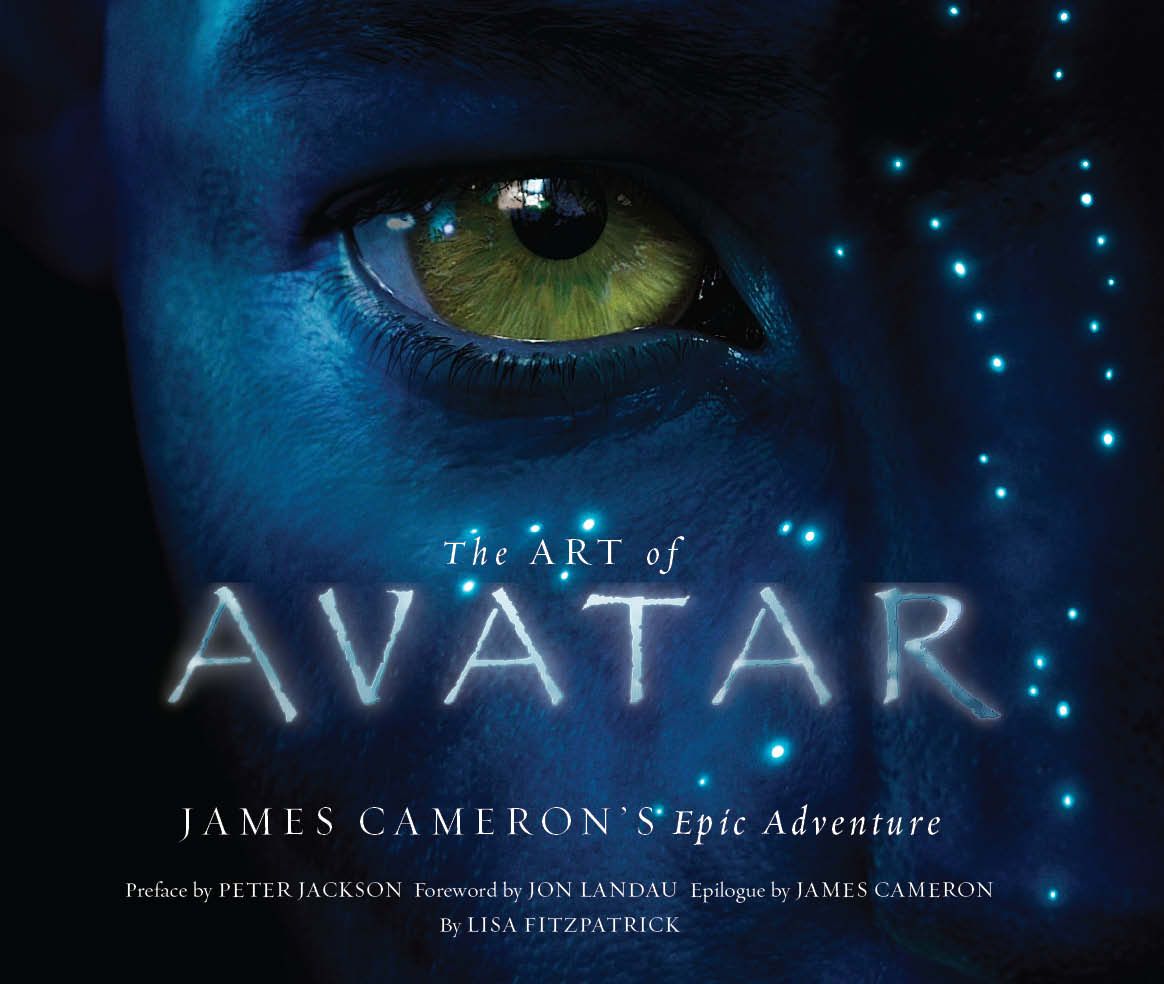
While planning and technology were essential nuts and bolts of its cinematic architecture, they alone do not constitute the blueprint or heart and soul of a film such as Avatar, especially considering the ambitious multi-thematic plots and visual realm. Like any innovative, transformative concept or endeavor, Avatar began and ended with the simple sketch. In a gorgeous, 120 full-color illustration rich companion volume, The Art of Avatar, written by Lisa Fitzpatrick, James Cameron and Peter Jackson, provides a fully transparent visual documentation of the first phases of the development and conceptualization of Avatar. The book’s 200+ works of art include compositions by renowned film artists (Rob Stromberg, Wayne Barlowe, Ryan Church, Ben Proctor and Cameron himself), descriptive script excerpts, commentary and a guide to each component’s realization process. As Fitzpatrick notes in the book’s copy, “it is the artist behind the technology that makes the images of this book, and ultimately the movie, so remarkable.” Having seen both (review here), ScriptPhD.com wholeheartedly agrees.
Suspension of disbelief. The cornerstone of any creative compact between a film and its audience. A compulsory foundation for escaping into imagined worlds and embracing its characters and adventures. Notwithstanding this axiom, Avatar still represents a giant leap forward in the world of filmmaking, according to Peter Jackson, Oscar-winning visionary behind The Lord of the Rings and recently District 9. “Every once in a while, we will see a movie that transcends cultural barriers, genre and taste—a film that lives on in the minds of the audience, years after the fact, a film with a story, characters and dialogue so memorable that it creates its own mythology,” Jackson notes in his foreword to The Art of Avatar. A project of such magnitude can initially seem insurmountable. Executive Producer Jon Landau said he felt like a NASA engineer in 1961 when President Kennedy announced we were heading for the moon—only the moon in question was Pandora.
Much of the initial design was jump-started by Cameron, himself a talented illustrator and meticulously descriptive screenwriter. His own sketches included largely preserved concepts of Na’avi clothing and signature physical appeararance, including a complete design of the heroine Neytiri’s painted face. The humans’ habitat the Venture Star included an 11-page document on how the ship functioned, with physics and engineering details such as light-speed calculations, pod dynamics, engine thermodynamics and architectural plans. Cameron’s Avatar script treatment—a plot and content synopsis—included visual primers such as glowing phantasmagorical forest, purple moss [that] reacts to pressure, rings of green light, dreamlike, surreal beauty that allowed artists to create accurate renderings of Pandora’s biosphere (see below picture).

Content in The Art of Avatar is smartly divided into categories, including transport, science, gadgetry, and biology. Transport and gadgets, including the Valkyrie shuttle and the Samson untilitarian vehicle, are designed with layouts and specificities worthy of industry standards. Particularly impressive to The ScriptPhD were the details and accuracy of early renderings of the home base biolab, clearly conceived by a man with a profound respect for science. Illustrations of labs are laid out to look like actual labs, with incredible attention to the link unit allowing the humans to transform into their avatars and the incubator tubes housing avatars, by far the most challenging prop for Weta Digital to produce. As an example, the Armored Mobility Platorm (AMP) suit used by military to safely roam around Pandora was designed by TyRuben Ellingson to be functional and accessible (good viewing capacity, easy maneuvering, flexible joints, rearview mirrors). Pictured below is just one of a multi-page design book for the AMP suit alone!
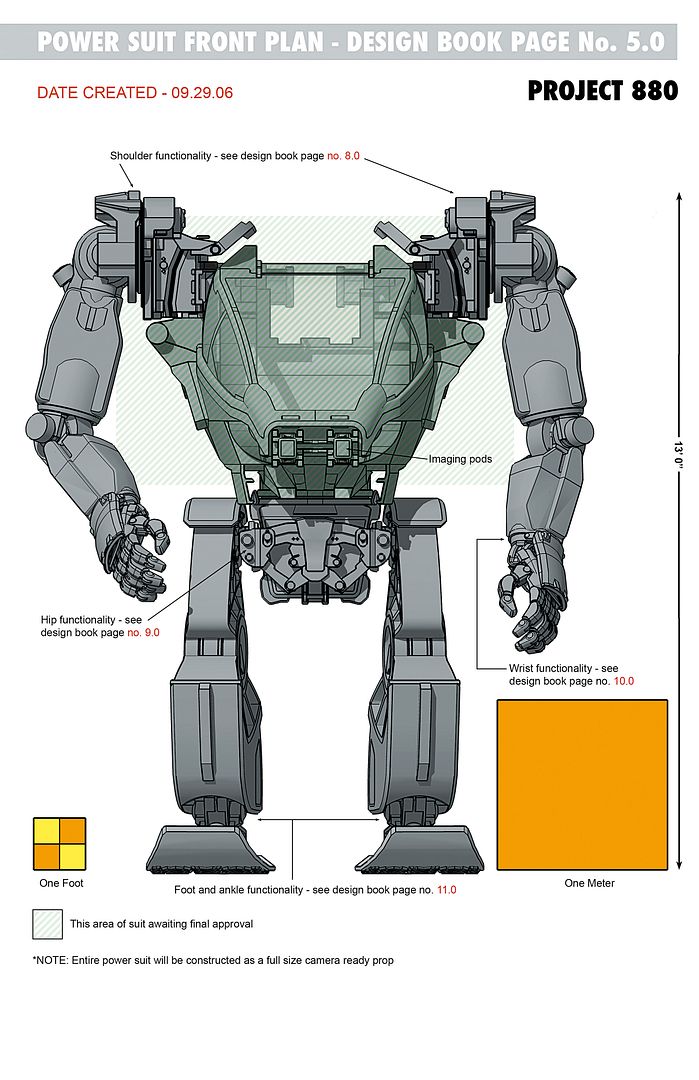
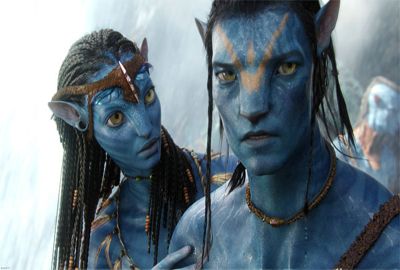
Biology illustrations are largely split categorically by flaura/fauna and creatures. Pandora’s many unique forests, the Home Tree and Floating Mountain key to the film’s plot, the illuminated foliage, and bioluminescent Fan Lizards and Woodsprites—original Cameron creations—each get individual renderings. In several pull-out pages, the creative process is gradual. Neytiri, for example, started as a pencil sketch, evolved into a clay figurine, then 3D artwork, and finally a screen version. Most interesting to note was the process of creating the original creatures of Avatar. The most critical and symbolic of these was the Banshee, a heroic creature that enjoys a lot of screentime in the film. It is meant to be a metaphor for the eagle, and, as a transport vehicle for the Na’avi, to represent them as a flying culture. Take a look at the transition between an early automotive biomechanical concept sketch by designer Wayne Barlowes and final color digital drawings.
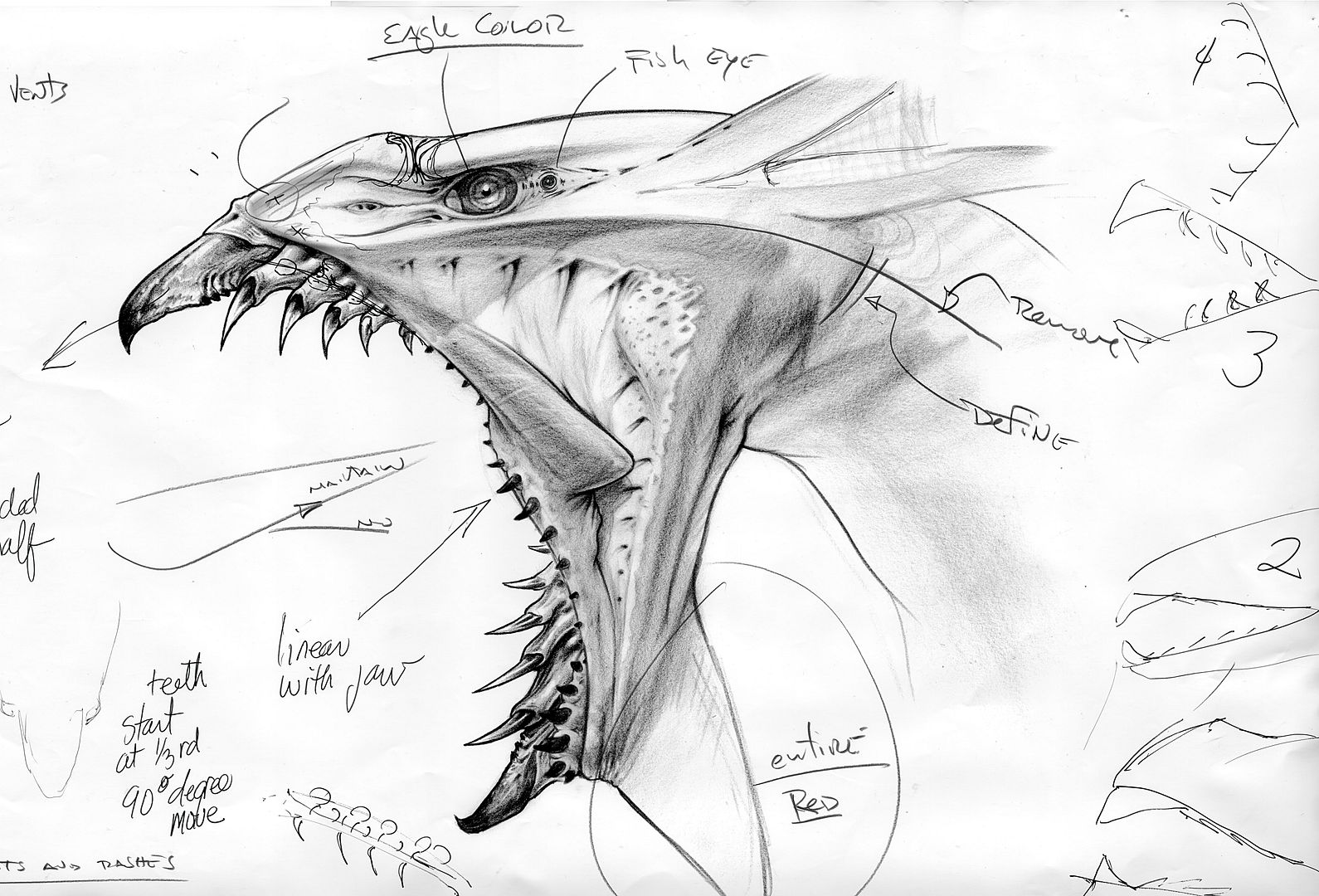
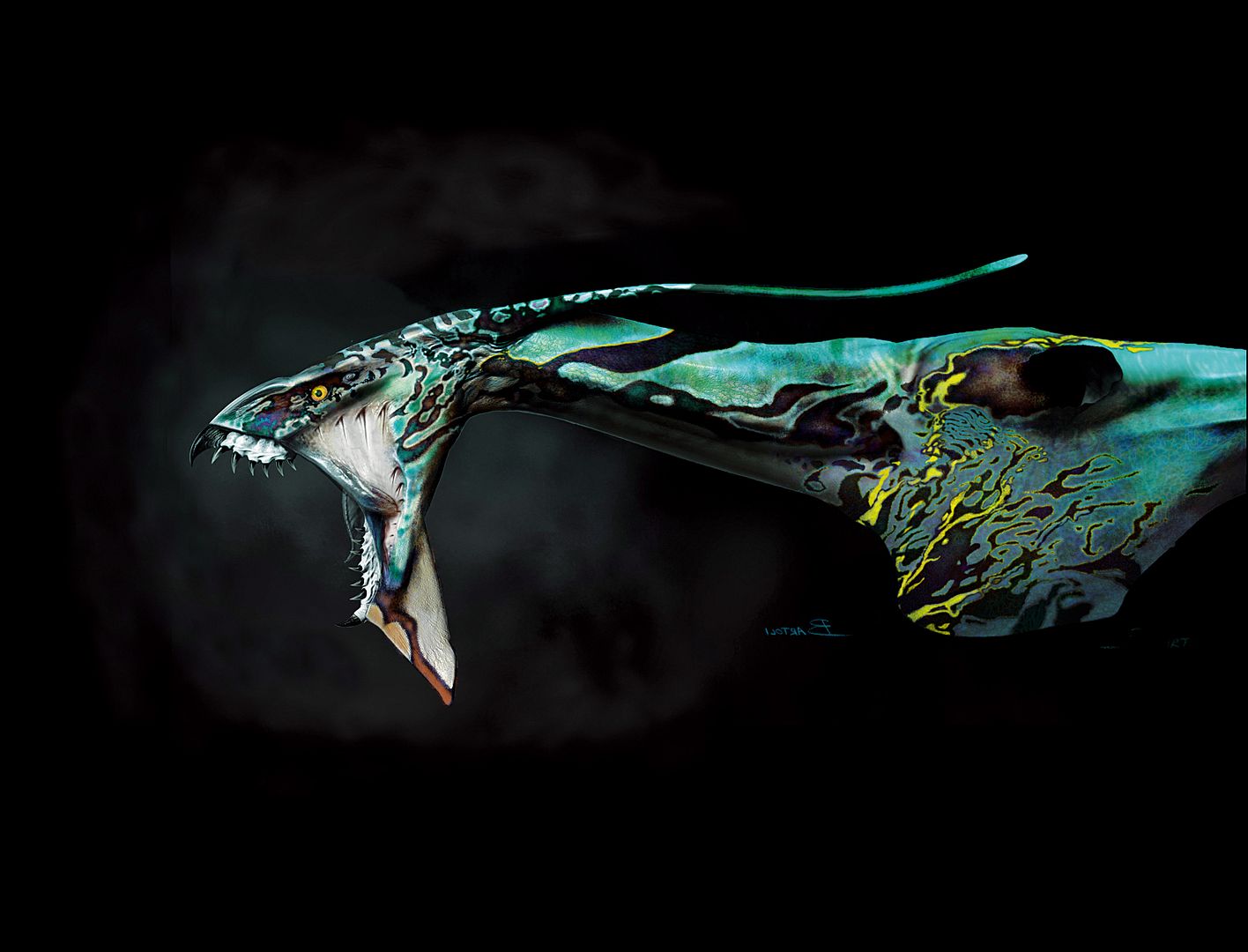
In an exclusive epilogue, James Cameron confesses that he feverishly wrote Avatar in 1995 over the span of just three weeks, fueled largely by his own imagination, every piece of fantasy art ever created, and his rigorous, extensive experience under the ocean. While certain things were specific to Cameron’s preferences—namely the Thanator and Viper wolf drawn by himself—all others were achieved through a sometimes turbulent, always rewarding collaborative process with a talented team of artists, designers, scientists and technologists. “The goal [of the design] became to mix the familiar and the alien in a
unique way,” Cameron states. “To serve the metaphor and create a sense of familiarity for the audience, but to always be alien in the specifics.”
Lucky, lucky audience.
Avatar Trailer:
The Art of Avatar was released November 30, 2009. Avatar wemt into wide release in IMAX and theaters nationwide on December 15, 2009.
~*ScriptPhD*~
*****************
ScriptPhD.com covers science and technology in entertainment, media and advertising. Hire our consulting company for creative content development.
Subscribe to free email notifications of new posts on our home page.
]]>
